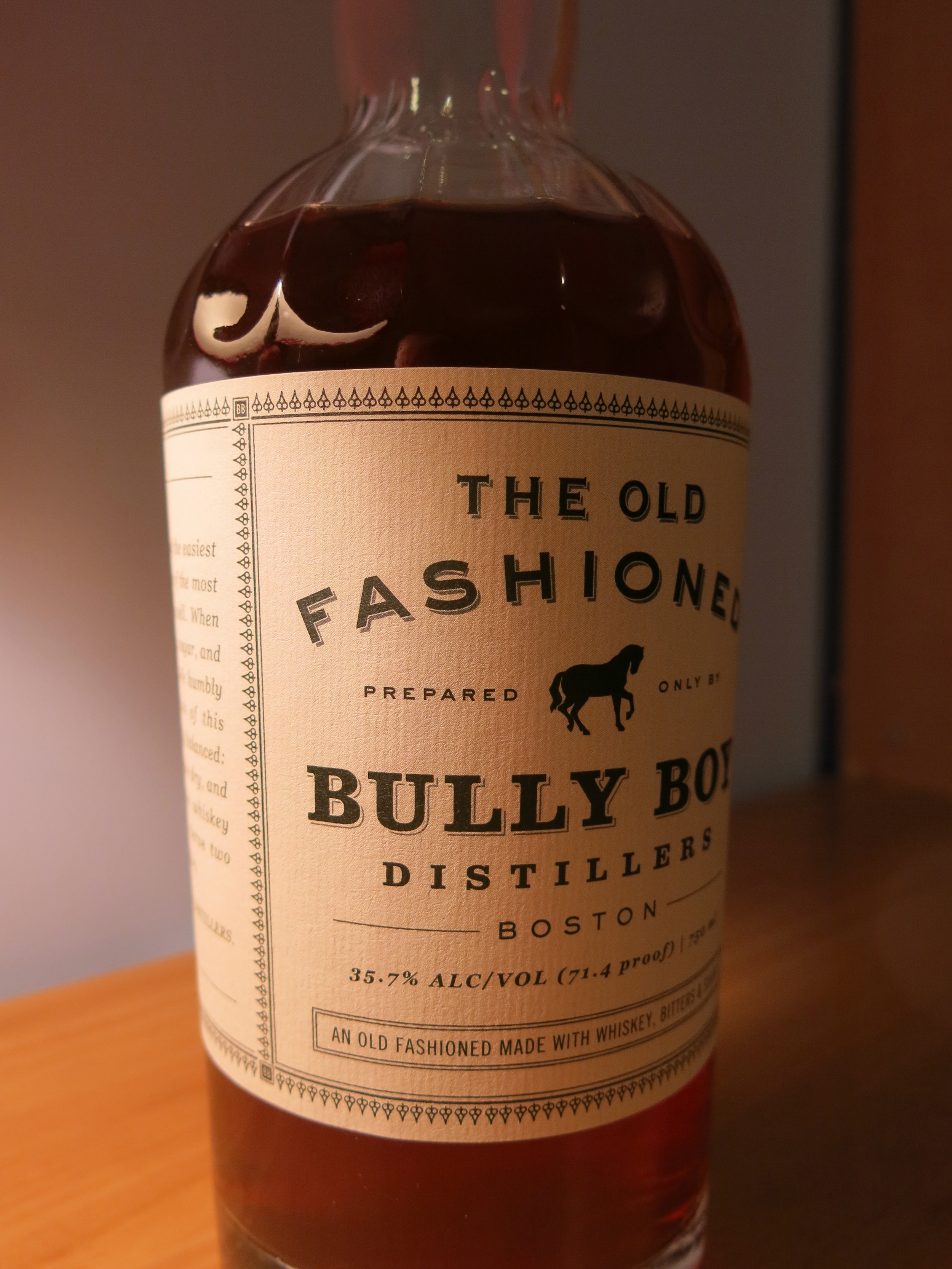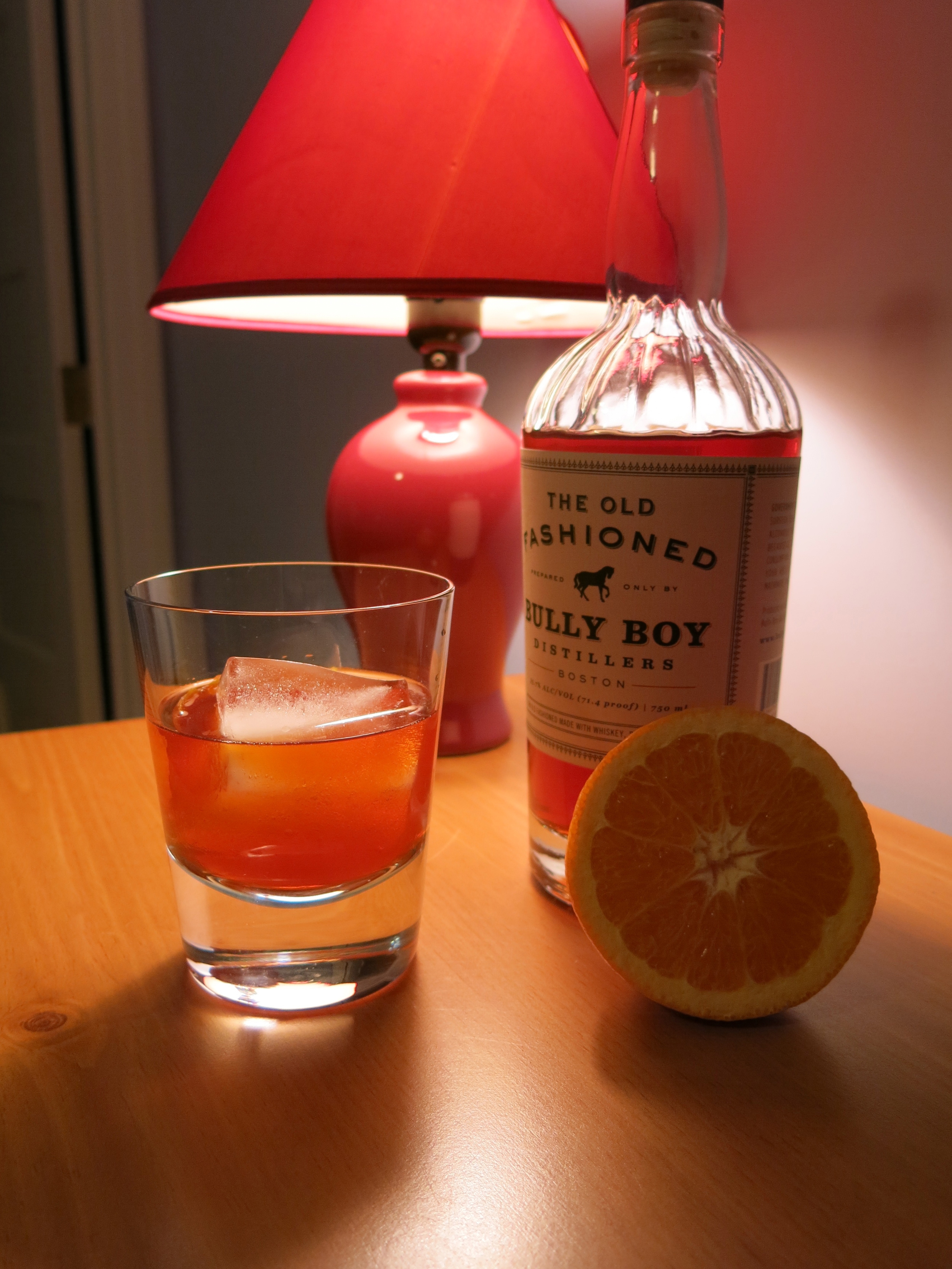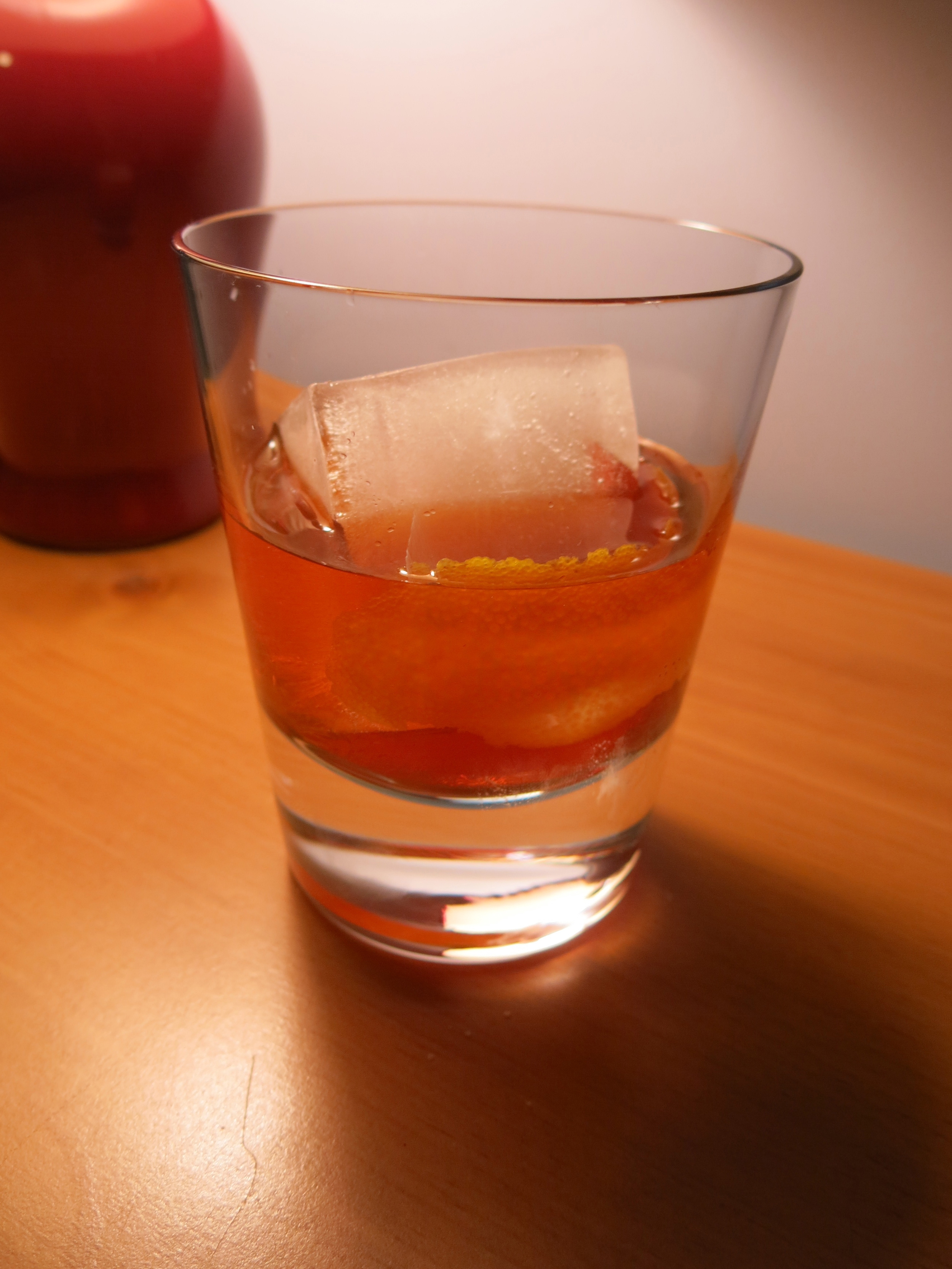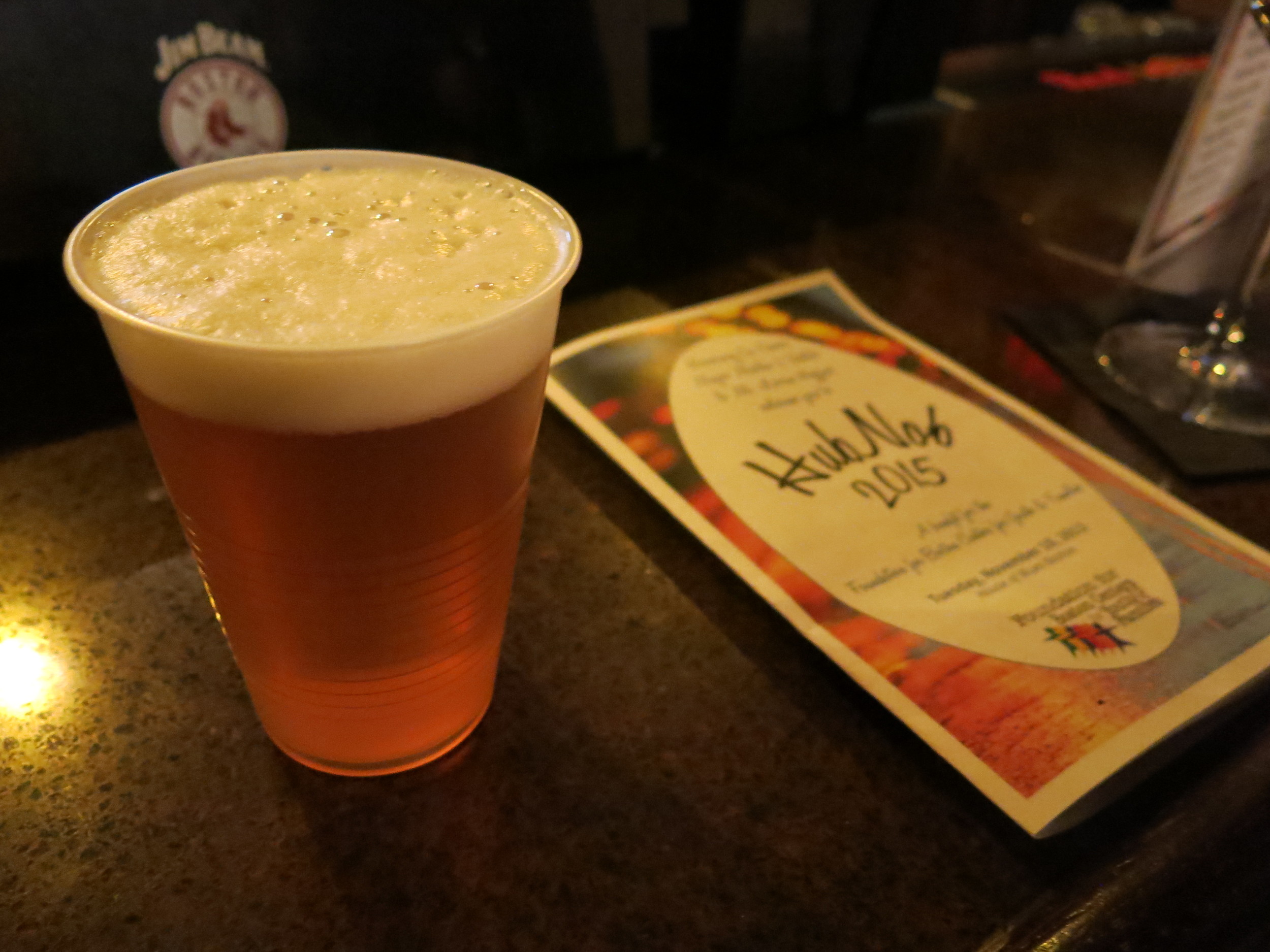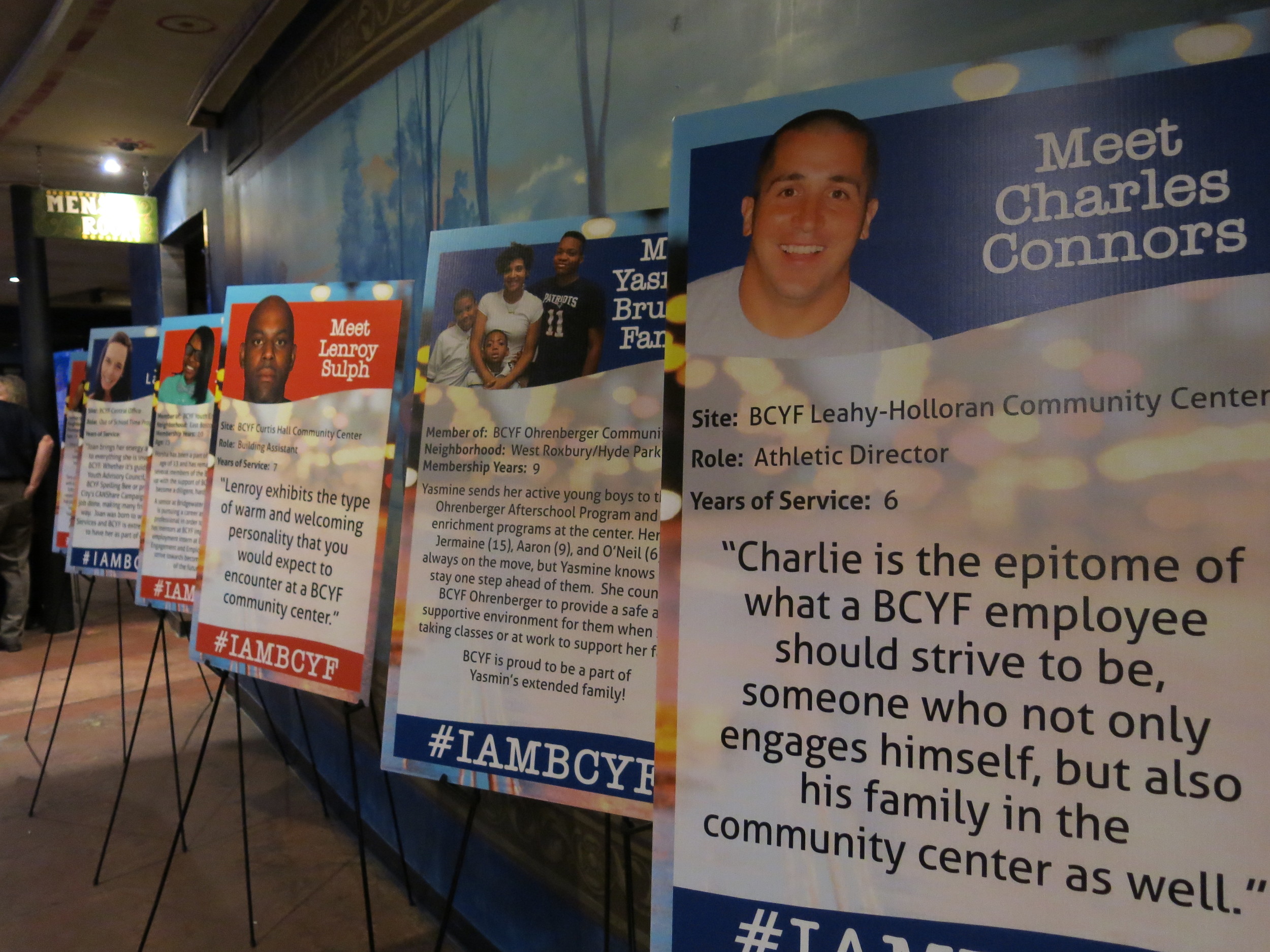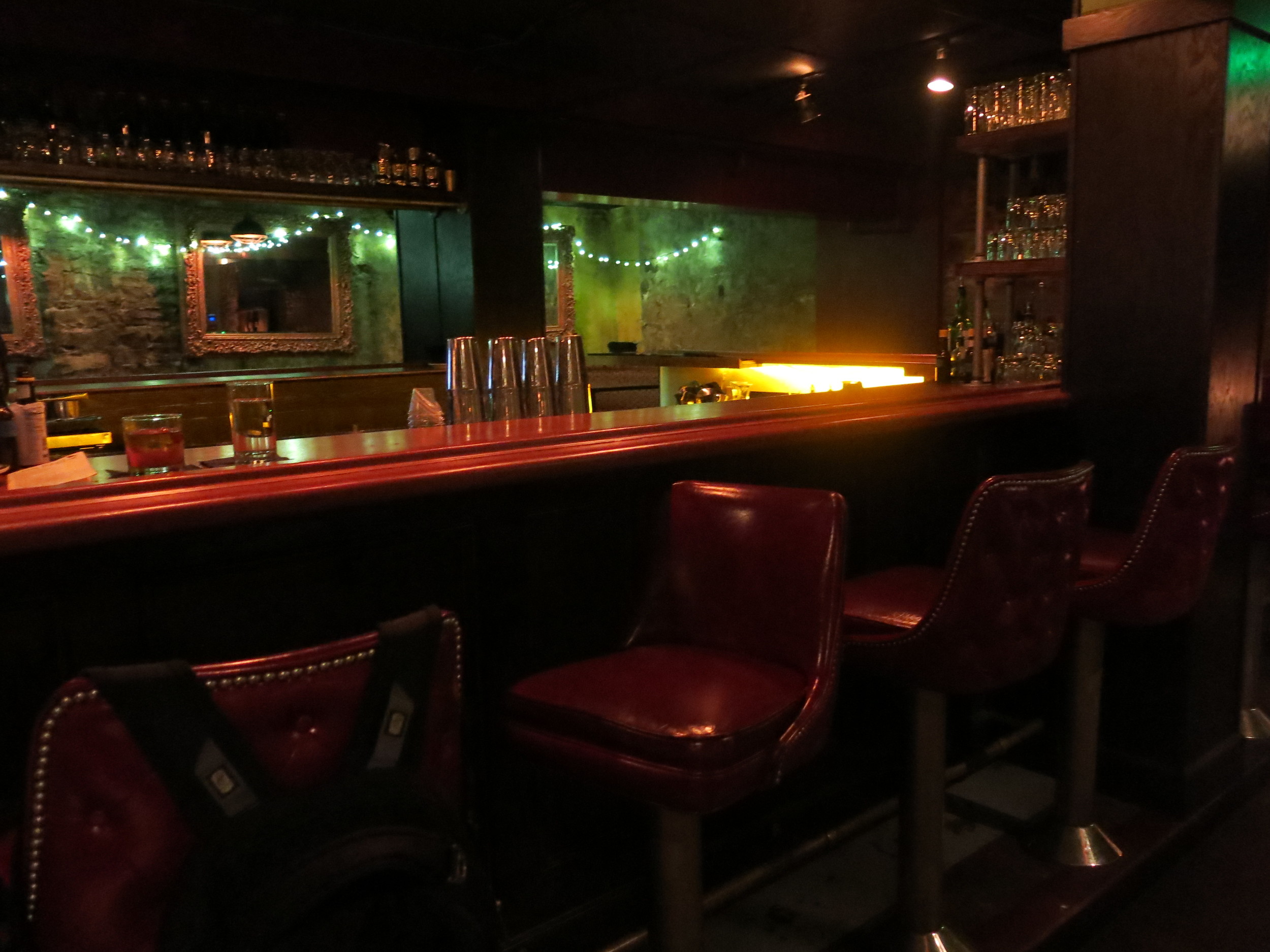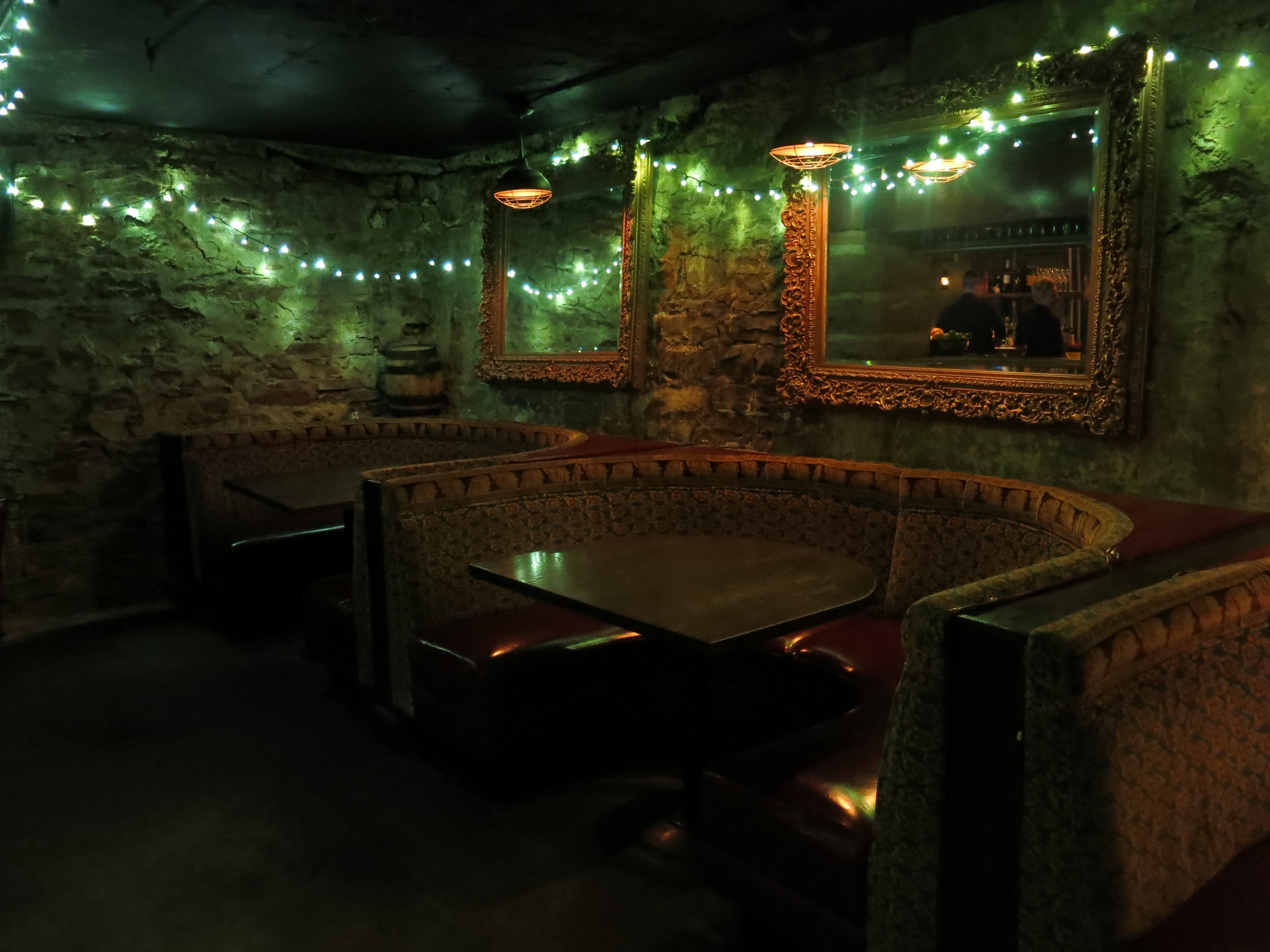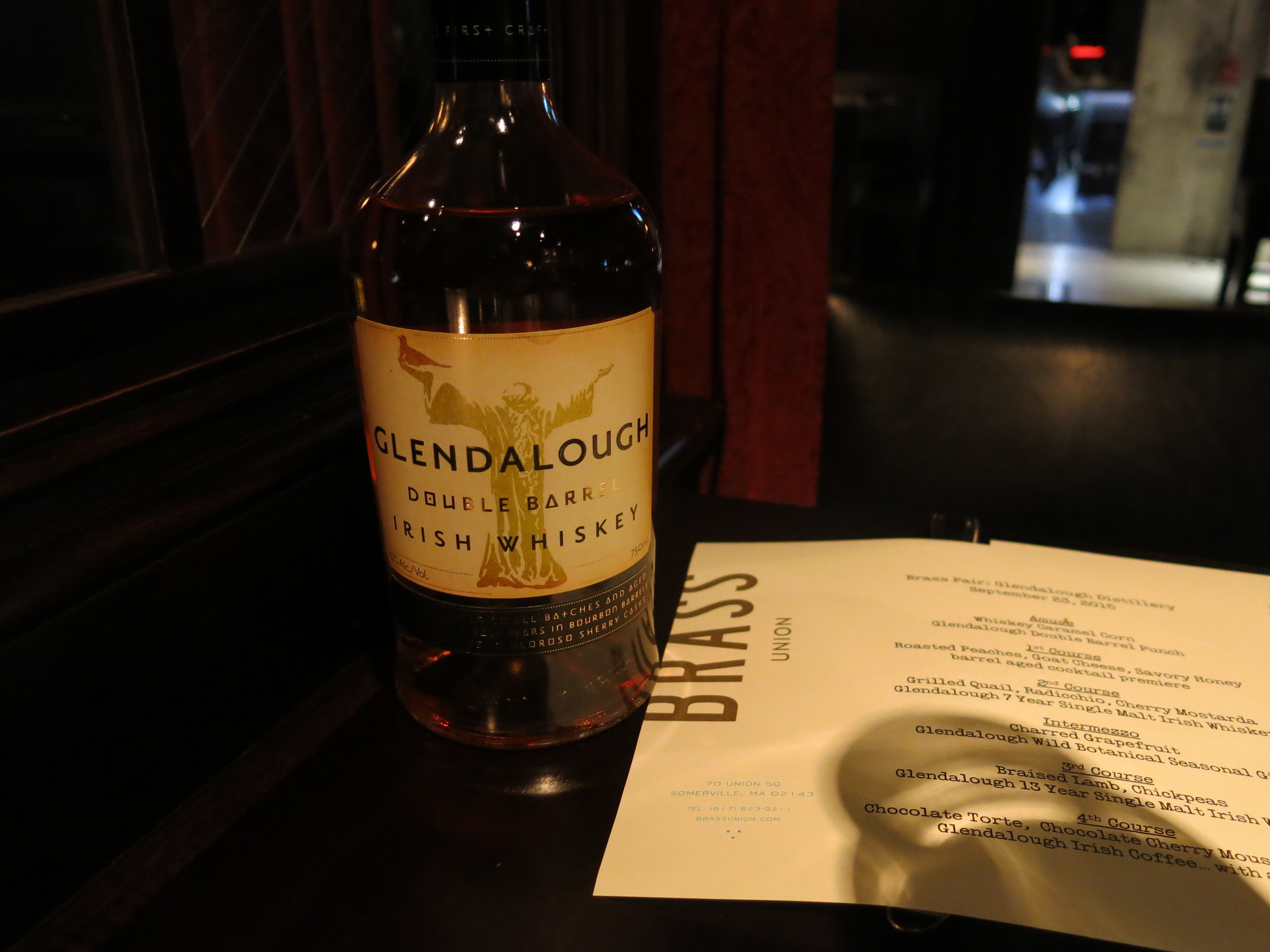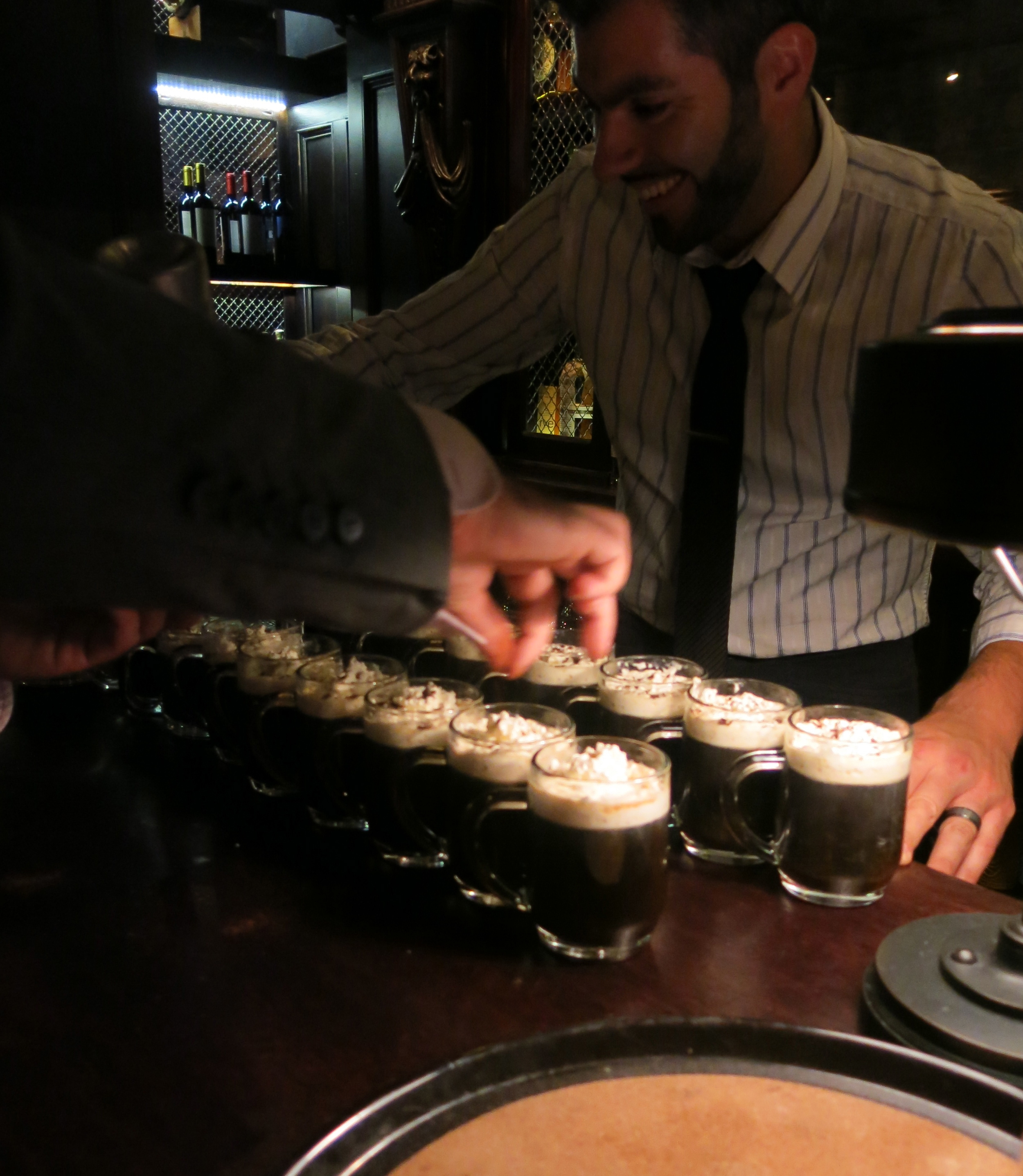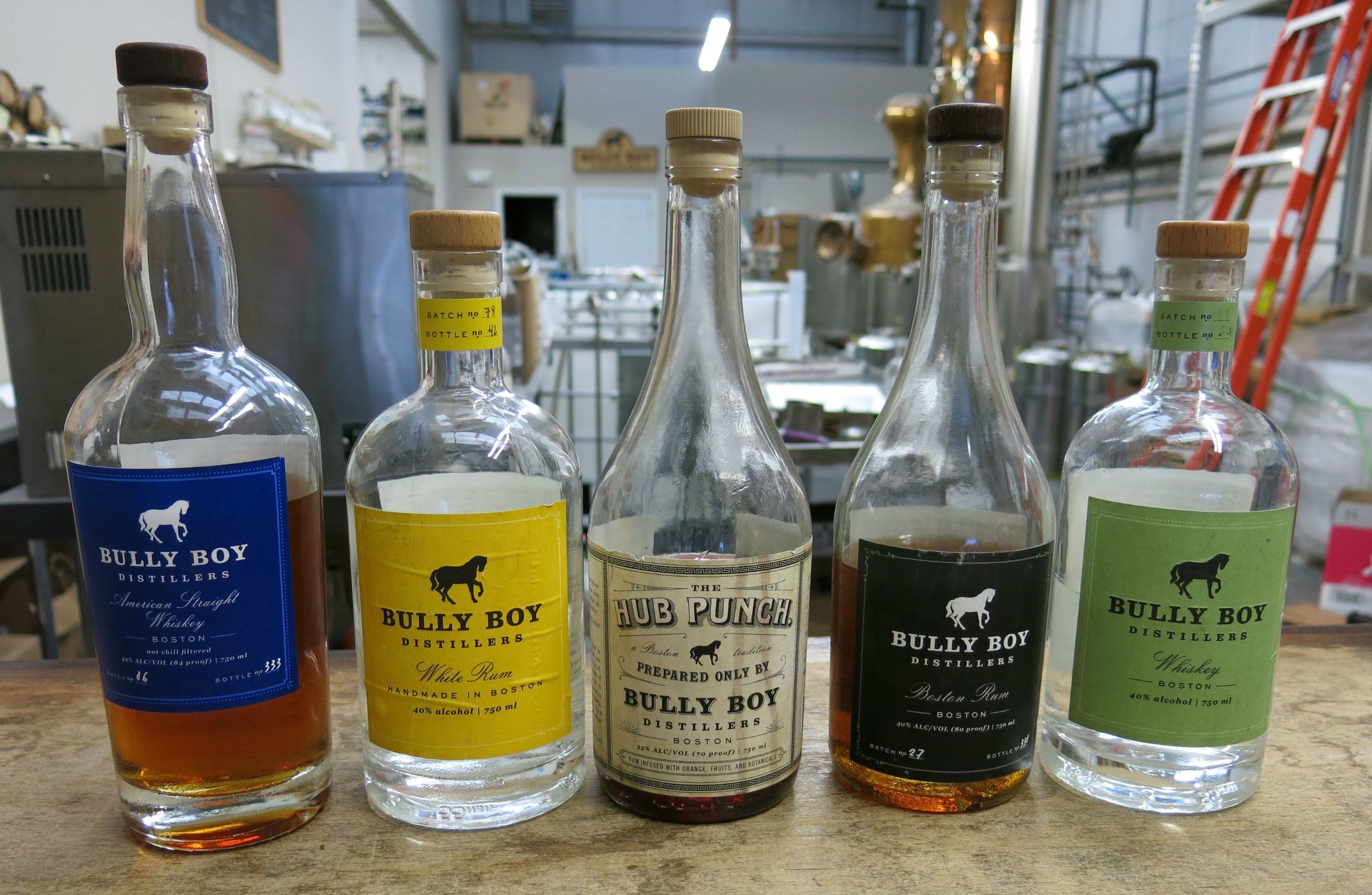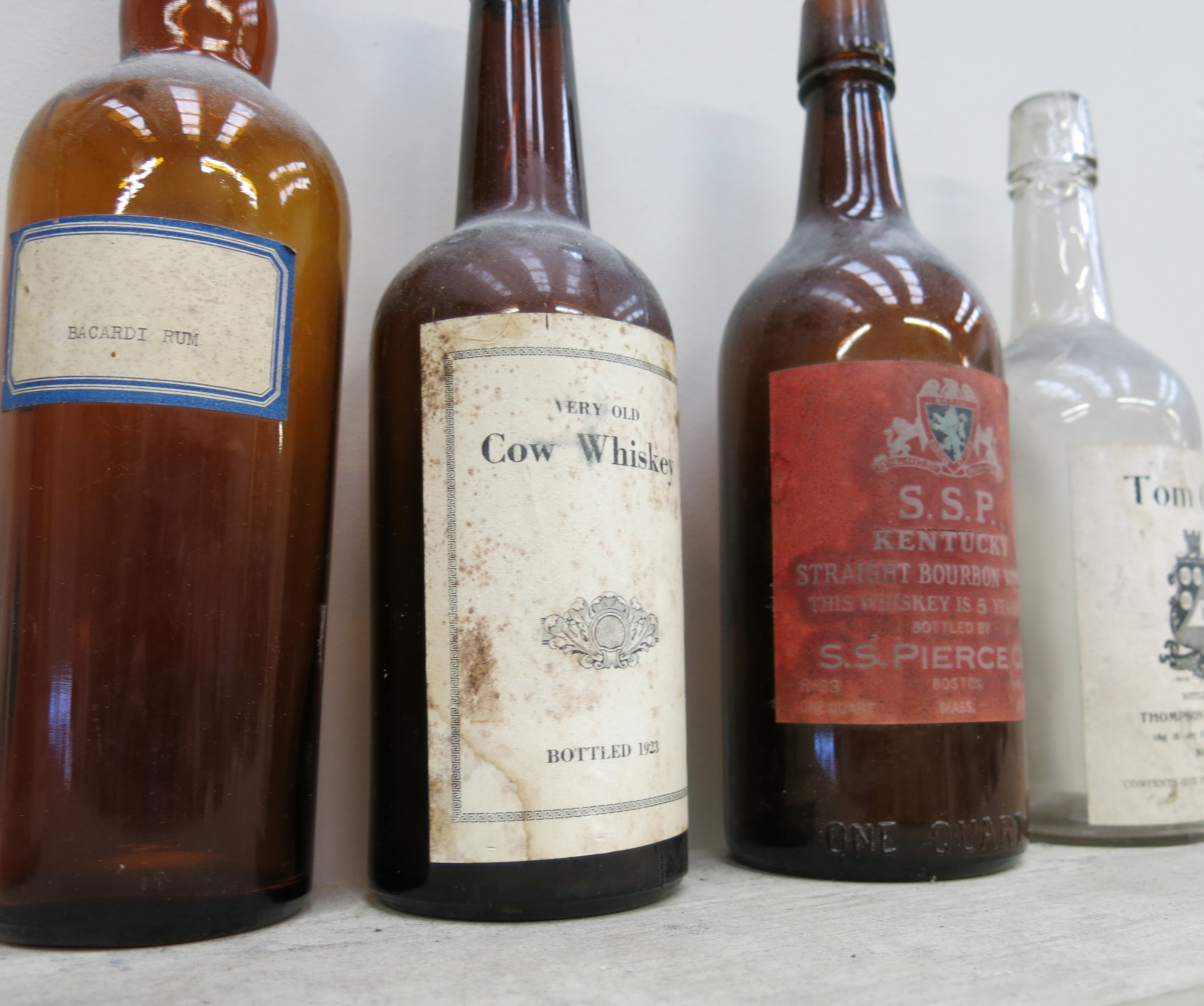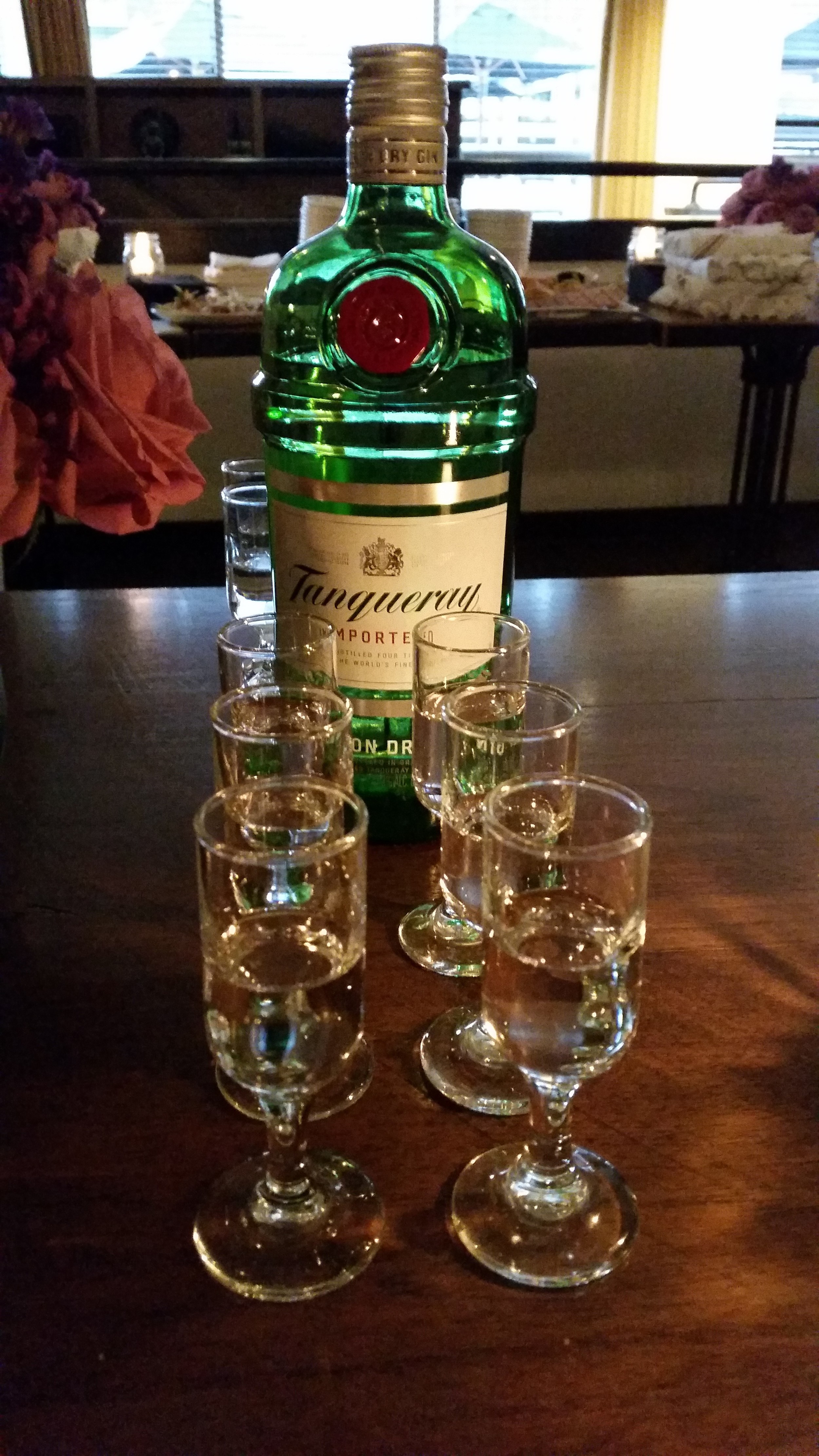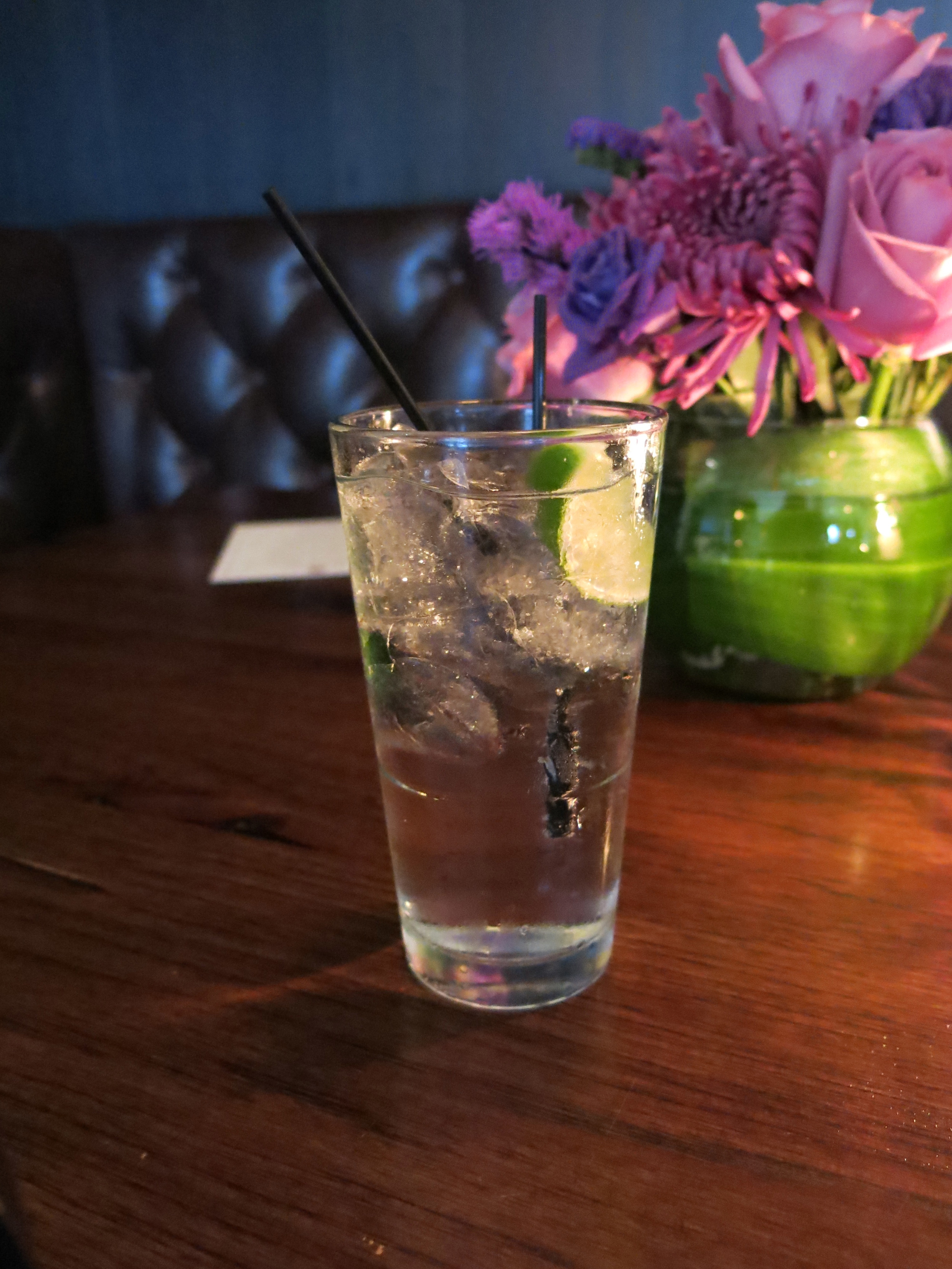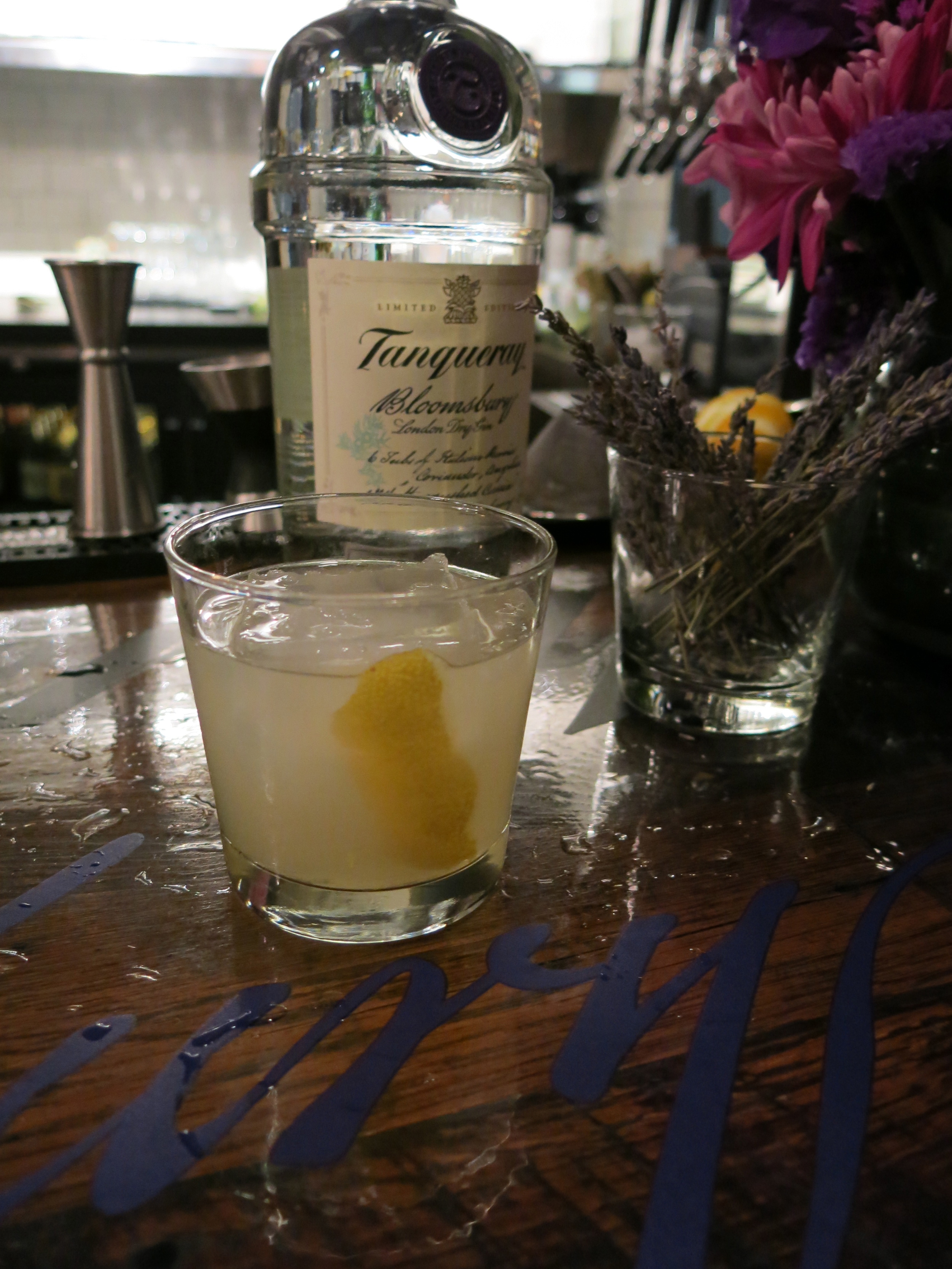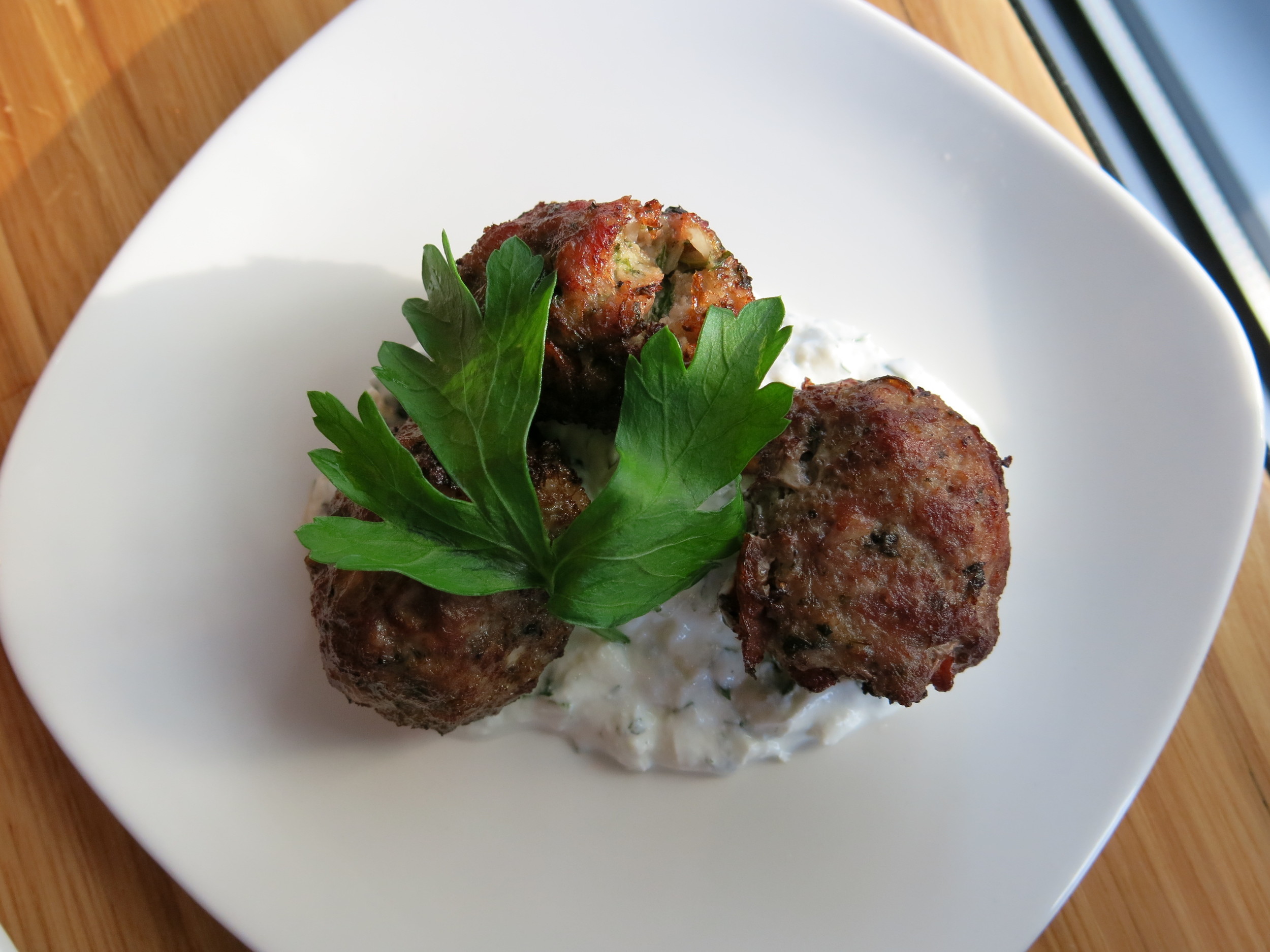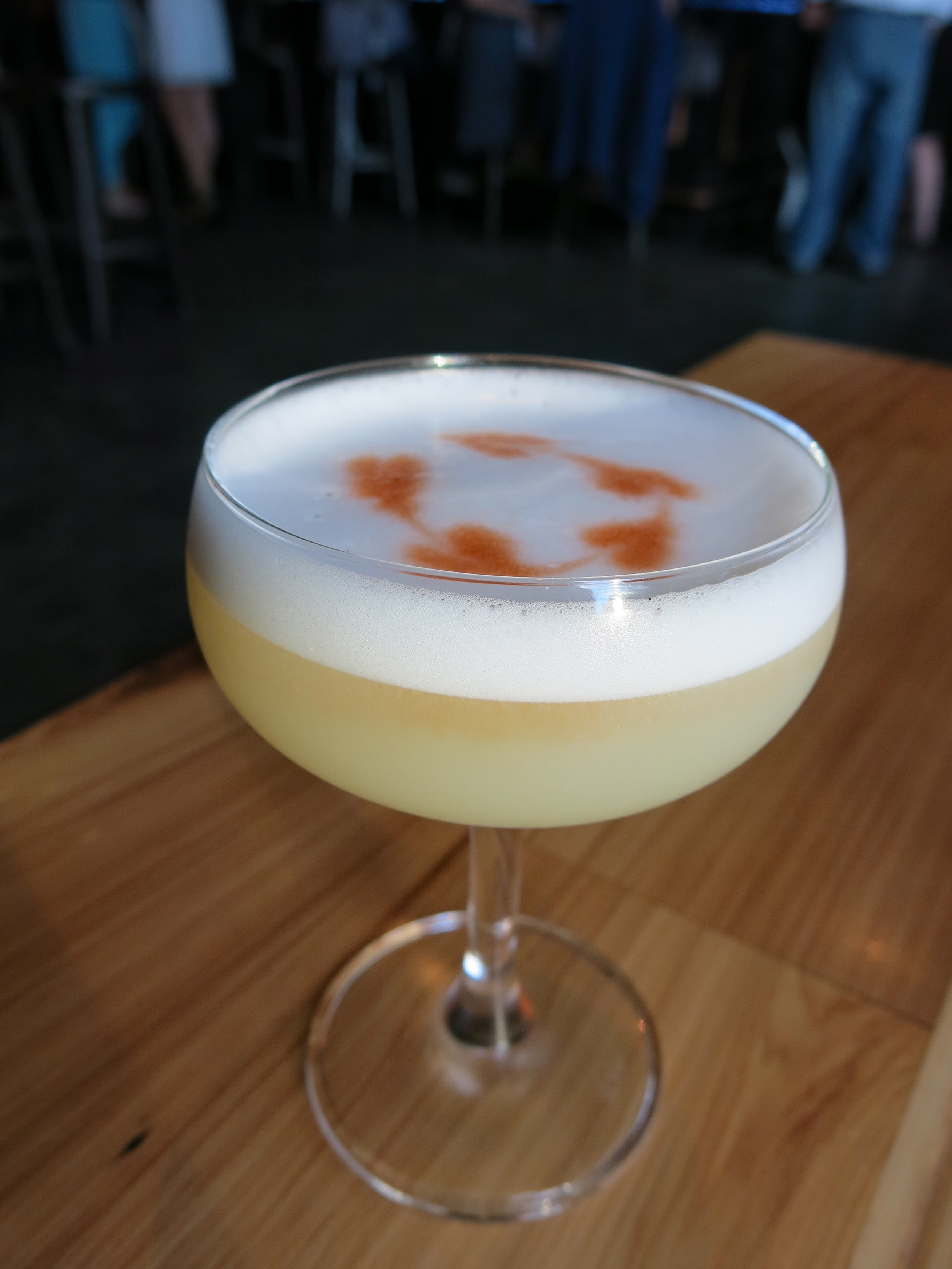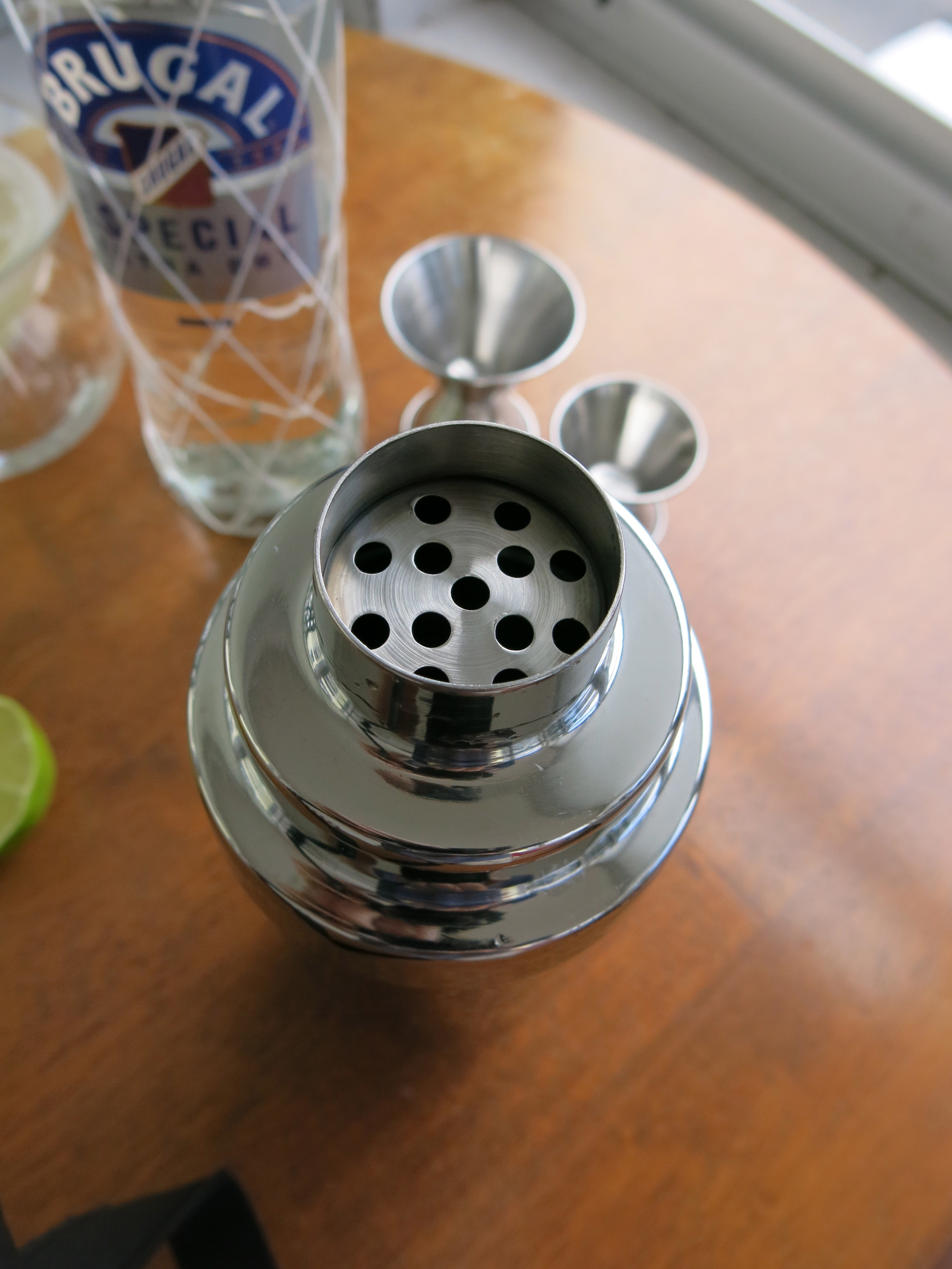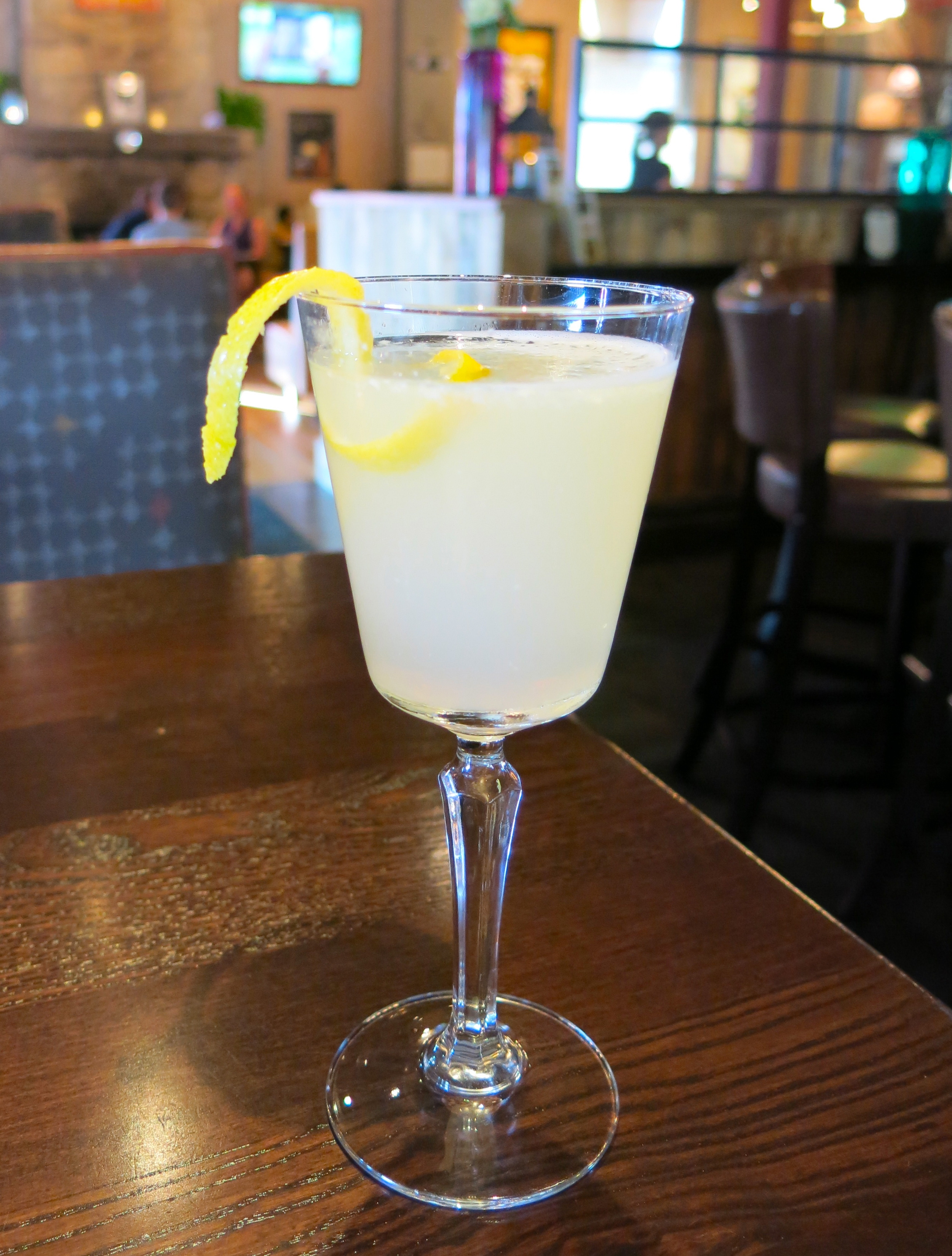Thelonious Monkfish
Second Annual Libations for Preservation
The Fourth Annual Boston BarHopper Christmas Special
It’s the Most Wonderful Time for a Beer
Outlook Kitchen + Bar at the Envoy Hotel
Colonial History of Craft “Cocktails”
Product Review – Bully Boy Old Fashioned
Making an Old Fashioned is easy. Screwing it up is even easier.
The Old Fashioned is one of the oldest and simplest cocktails in the book. It is the very definition of a cocktail – spirit, citrus, bitters, and sweetener. What could possibly go wrong?
Well, if you’ve ever ordered an Old Fashioned and been handed a glass of whiskey served over a graveyard of mutilated fruit and topped with soda water, then you know exactly what can go wrong.
For the record, the Old Fashioned is typically made by dropping a couple dashes of Angostura bitters in a quarter ounce of simple syrup in a rocks glass, muddling an orange peel in the mixture, adding two ounces of whiskey, stirring, and then plopping one or two large ice cubes into the mix. That’s not a definitive recipe, and there are plenty of wonderful variations. Some people use lemon instead of orange, or use the peel as a garnish instead of muddling it. A sugar cube is a classy alternative to syrup. Some drinkers prefer bourbon; others, rye. Even whole slices of muddled fruit are OK, within reason.
And yet this drink has a way of going off the rails. I’m not opposed to having a little fruit in there, but I’ve seen Old Fashioneds served with a mash of orange, lemon, maraschino cherries, even pineapple – sometimes all in the same glass. Then there’s the soda water, which for some reason I find particularly galling.
I’ve read that the trouble began during Prohibition. An Old Fashioned made with whiskey distilled in some guy’s garage was probably vile, so disguising the astringent flavor with fruit and soda was probably wasn’t a half-bad idea. Unfortunately, the practice survived the so-called Noble Experiment and persisted until fairly recently. This glorious craft cocktail renaissance has elevated our standards, and many bartenders have sought to restore the Old Fashioned to its purer, more traditional form.
And yet, even without the extraneous ingredients, a truly exceptional Old Fashioned is hard to come by. Dave Willis, co-owner of Bully Boy Distillers, thinks the most common misstep is not adding enough bitters.
And he blames the bottle. “When you use a bottle of Angostura bitters, it’s really, really difficult to determine how much bitters you’re adding and how much bitters you should add, because it has that odd sort of drip/pouring mechanism,” he explained to me when I visited the Bully Boy distillery back in August. “So I use a lot of bitters.”
Why should you care about how much Angostura Dave uses in an Old Fashioned? Because he’s something of an authority on the matter – as he’ll tell you. “Not to toot my own horn, but I make an unbelievable Old Fashioned,” he humbly declared when we met this summer.
If you don’t believe him, you can try his version for yourself. Last month, Bully Boy released a bottled Old Fashioned made in accordance with Dave and his brother Will’s recipe for this classic cocktail. It’s a limited release product that will be available through the winter months.
While bottled cocktails are becoming more common and improving in quality, there’s still a tendency to be leery of any prepared version of a craft drink. But there’s nothing in Bully Boy’s bottle that doesn’t belong – just whiskey, muddled raw sugar, and Angostura bitters. As for Dave’s comment about using “a lot of bitters,” that’s a phrase that takes on a different meaning when you consider that he and Will acquired a 50-gallon drum of the stuff while they were batching the cocktail. Dave explained that working with such large quantities enabled them to better control the proportions, as opposed to the guesswork that accompanies the drips and dashes from the usual bottle of Angostura.
The base spirit is Bully Boy’s aged American Straight whiskey, made from corn, rye, and malted barley. With flavor notes common to both bourbon and rye whiskey, it’s well suited to an Old Fashioned.
As a lover of Old Fashioneds (and as someone who takes pride in making a respectable one), I can say I’m genuinely impressed with the final product. True to Dave’s good-natured boast, it’s an outstanding interpretation. The ingredients are beautifully balanced – just the right amount of sugar and bitters, and the whiskey is notable for its unique blend of sweet and spicy notes.
The Willis brothers suggest muddling an orange wheel and a maraschino cherry. That’s more fruit than I’d ordinarily use, but the combination does work pretty well. Still, I prefer just an orange peel. With a little less fruitiness, the spicy notes of the whiskey stand out and the flavor of the bitters is more prominent.
Bully Boy hasn’t just idiot-proofed the Old Fashioned; they’ve elevated it. Their bottled product is convenient for anyone who struggles to perfect this classic drink but is good enough to satisfy skeptical connoisseurs.
Will and Dave recommend pouring “two fingers” of the cocktail, a generous and utterly satisfying measure of it, over a large ice cube.
Nowhere do they recommend using soda water.
I received a complimentary bottle of the Old Fashioned from someone associated with Bully Boy. I was neither asked nor expected to write a review of it. The opinions expressed here are, as always, my own.
* * * * * * * * * * * * *
Copyright © Boston BarHopper. All Rights Reserved.
HubNob 2015
Eating, drinking, and dancing, all while raising money for a great cause. Not a bad way to spend a weeknight. This past Tuesday, the House of Blues served as the setting for HubNob 2015, an annual fundraising event for the Boston Centers for Youth & Families (BCYF) and its nonprofit partner, the Foundation for the BCYF. The BCYF is the city’s largest human services agency, operating a network of community centers and fostering positive opportunities for Boston’s youth and families. HubNob, now in its fifth year, is the foundation’s signature event.
It’s inspiring to see a community coalesce around such a meaningful cause. In addition to a capacity crowd that paid between $60 and $100 to attend, many local organizations donated time, services, products, and money to the event, and a number of local luminaries were on hand to lend their support.
The festivities began with a VIP reception in the upstairs Foundation Room that featured music by the heavily inked singer Lisa Bello; food by Devlin’s Bistro, in Brighton, and Pikalo, a Jamaica Plain establishment that makes some killer empanadas; and plenty of Harpoon IPA.
Jenny Johnson, host of NESN’s Dining Playbook, served as the reception’s emcee and auctioneer. She talked about the foundation, introduced key guests such as BYCF interim executive director Christopher Byner and Mayor Marty Walsh, and auctioned off unique prizes such as a Boston Celtics package that included courtside seats and access to the pre-game warmup.
Mayor Walsh spoke at length about the important work that the BCYF does and offered some heartfelt personal tributes to several of the key individuals who have devoted so much of their time and energy to making the organization successful.
The main event took place downstairs, and a packed house enjoyed food from a dozen Boston restaurants, including Pastoral, Brahmin, Chicken & Rice Guys, and Crave.
On emcee duty was José Massó, host of ¡Con Salsa!, a long-running radio show on WBUR.
The evening’s soundtrack came courtesy of Soul City, an energetic 10-piece band that got everyone’s feet moving with a stellar R&B set list.
Guests could bid in a silent auction with nearly two dozen unique prizes, including an autographed (and fully inflated) Tom Brady football, Bruins tickets, and a pair of round-trip tickets anywhere that JetBlue flies.
And there were cupcakes.
Lots and lots of cupcakes.
All told, this was a spectacular evening with a lot of energy and a lively crowd. I don’t know what the final fundraising tally was, but given the turnout at both the VIP reception and the main event, it’s clear that a great many people care about the BCYF and are eager to support it.
Proceeds of the evening will be used to help the foundation develop new professional and social opportunities for Boston teens. It’s work that never stops, but an event like HubNob is a chance to celebrate BCYF’s success while ensuring that its efforts can continue.
* * * * * * * * * * * * *
Copyright © Boston BarHopper. All Rights Reserved.
CHOPPS
One for the Road – Green Russell
I recently had the good fortune to travel to Colorado, my first-ever trip to the Centennial State. I spent some time in Estes Park, a resort-like town about 70 miles northwest of Denver that serves as the base camp for Rocky Mountain National Park. If you’ve never been, take it from me – the scenery there is absolutely breathtaking.
Wherever you are, and whichever way you turn, the majestic peaks of the Rockies are on your immediate horizon. And when you’re exploring the mountains themselves, either by car or on foot, the experience is truly fulfilling. My very soul felt somehow renewed by gazing at the stunning vistas and breathing that crisp Rocky Mountain air.
It would far exceed my writing or photography skills to faithfully convey the essence of that experience, so I’ll stick with what I’m reasonably good at. After a few days in Estes Park, I traveled to Denver. Now, Colorado is a beer state, widely known and renowned for its concentration of breweries. But its capital city also boasts a pretty impressive cocktail scene. A growing number of Denver bars have won national acclaim for their innovative approaches to mixology. One, Williams & Graham, was even named Best American Cocktail Bar at this year’s Tales of the Cocktail conference in New Orleans.
With so many choices and so little time, I relied on a friend’s advice and opted to check out Green Russell, a subterranean, speakeasy-style bar in the heart of historic Larimer Square. As with many modern speakeasies, finding Green Russell means knowing where to look. At first, the bar appears to be clearly marked, with a sign above a flight of stairs leading below ground level. You walk in, see a pretty conventional-looking bar to your right, and think, “Well that wasn’t so hard to find.” But not so fast! That’s the bar of Russell’s Smokehouse, a barbecue restaurant.
So, if you’re like me and aren’t familiar with the place, you’ll awkwardly amble over to the hostess and say, “Yeah, I’m looking for the bar? Uh, not that bar, but I guess there’s another, uh...bar…” at which point she’ll mercifully put an end to your blather and ask you for your name and the number of people in your party. After a few minutes (10 minutes in my case, since the bar hadn’t opened yet, which only added to the awkwardness; and I’ll tell you, nothing makes you feel more like an alcoholic than standing outside a bar by yourself, waiting for it to open), someone leads you beyond a pair of service doors that give you the impression of sneaking into the kitchen of a bakery. Past the doors is no bakery, though, but a dark room that looks like a partially finished basement with a fancy bar set up in it. In other words, like a speakeasy.
But unlike so many bars that try to capture the look and feel of a 20s-era illicit watering hole, Green Russell’s speakeasy character has genuine historical roots – the space actually did serve as a speakeasy during Prohibition. It certainly looks the part, with its rough-hewn stone walls, wooden posts, dim lighting, and vintage fixtures.
But as the bartender explained to me, Green Russell calls itself a pre-Prohibition bar, focusing on classic drinks and techniques that were in vogue before the so-called Noble Experiment. Think fresh, house-made ingredients and hand-chipped ice.
Further, the emphasis here is less on secrecy and more about fostering a comfortable drinking experience, with the cocktail appropriately at the center. The small space can be busy, but not jam-packed – you’re admitted to the bar only when your whole party can be seated. Enjoy talking on your phone while you’re at a bar? There’s a phone booth for that. And if you truly don’t know how to comport yourself in a modern cocktail lounge, there’s a sign at the door offering a few helpful suggestions.
Overall, Green Russell is built around the experience of enjoying a well-crafted cocktail, and my own experience was outstanding. Maybe it’s because I was there early on a weeknight, or because I was alone, but I got such individualized attention that my bartender, Heather, seemed more like a guide – offering suggestions, answering questions, and making conversation.
At the heart of this “chef-driven cocktail joint” is a dynamic, highly contemporary beverage program that features a dozen seasonal offerings, several barrel-aged cocktails, and a “bartender’s choice” option, if you’re willing to put your faith in your bartender. (Note: The drinks in this story were part of Green Russell’s summer menu; I assume the fall offerings are what you’ll find now.)
At Heather’s suggestion, I began with the Castle Black, inspired by the ancient, beleaguered center of defense against supernatural predators in the Game of Thrones series. This vibrant drink combined two brands of 10-year-old scotch – Glen Grant and Laphroaig – along with Amaro Lucano, black pepper, and citrus bitters. The pepper served to intensify the smokiness of the scotch, and despite the gloomy name, the citrus gave the drink an overall sense of brightness.
Normally at this point I’d explore the menu a little further, but since Heather’s first recommendation was so good, I opted for the bartender’s choice. I expressed a preference for bourbon, and she responded with a creative variation on a Manhattan. Combining Evan Williams Single Barrel bourbon, Amaro CioCiaro, maraschino liqueur, and angostura bitters, the drink had a bold, deep sweetness with distinct orange notes from the amaro. The maraschino liqueur added a little dryness and bitterness.
Since I’m a sucker for good gin and bad puns, my next choice was the Mousse with the Fir, a mix of St. George’s excellent Terroir gin, Pampelmousse grapefruit liqueur, black pepper, lemon, and mint. This sour, invigorating cocktail had a complex but well-balanced blend of herbs and botanicals, with just a hint of sweetness. (I appreciated the clever name but was unhappily stuck with that “boots with the fur” song in my head for the remainder of the weekend.)
Green Russell’s food program largely comprises bar snacks that are equal parts inventive, upscale, and playful, such as candied spiced nuts, brisket sliders, and pigs in a blanket. The emphasis is on shareable dishes, but most are substantial enough to serve as full serving. I went with the delicious charred octopus, served with hush puppies, smoked aioli, and a spicy chorizo salsa verde.
For my final drink of the evening, I again deferred to Heather’s judgment. Deciding that I needed a rum drink to complete the equation, Heather consulted some of her personal notes before whipping up a doozy. Made with Appleton dark rum, silver rum, maraschino liqueur, and Cocchi Americano vermouth, this potent cocktail balanced strong sweet and herbal notes, ending with a surprisingly smooth finish that lingered on the palate. It was a thoughtful combination of ingredients and a satisfying (if boozy) conclusion to the evening.
It’s easy to get carried away with the speakeasy theme, and some bars allow novelty to trump substance. The ones that get it right, like Green Russell, use the motif as a means to elevate the cocktail experience. The focus here is on creative drinks and a talented, attentive bar staff – not passwords and gimmickry. And if that means standing outside those nondescript kitchen doors for a little while, chances are your patience will be rewarded.
Address: 1422 Larimer Street, Denver, Colorado
Website:http://www.greenrussell.com/
* * * * * * * * * * * * *
Copyright © Boston BarHopper. All Rights Reserved.
Glendalough Whiskey Dinner at Brass Union
Gaining a foothold in the spirits industry is challenging under any circumstances. But when you make Irish whiskey and operate in the shadow of a market-dominating behemoth like Jameson, even getting people to know your brand name can be a tall order.
That’s one reason why it’s easy to root for Glendalough Distillery. Founded in 2011 by five friends from Dublin and Wicklow, the microdistillery opened its doors right around the time that the last independent distillery in Ireland was sold to a multinational corporation.
That makes Glendalough the first modern craft distillery in the Emerald Isle – a fairly remarkable claim in a country with a centuries-long history of distillation.
I first became familiar with Glendalough’s spirits earlier this year, when I met co-owner and brand manager Donal O’Gallachoir. And that’s probably how a lot of people got introduced to Glendalough. You’re unlikely to see a big, glitzy Glendalough ad campaign anytime soon, but you do stand a fair chance of running into the U.S.-based O’Gallachoir somewhere around town.
Donal’s a charismatic chap with an inexhaustible supply of entertaining stories, a passion for Irish whiskey, and great pride in his distillery’s spirits. His enthusiasm is infectious and has likely played no small part in Glendalough’s growing popularity. You can now find it in 14 states and countless Boston-area bars.
Whiskey Pairing
Last week I had a chance to get further acquainted with Glendalough’s spirits during a whiskey dinner at Brass Union in Somerville.
Pairing the distillery’s three whiskey offerings with specially prepared dishes, the event served to showcase not only the spirits but also the cocktail and culinary acumen of Brass Union beverage director Paulo Pereira and chef Jonathan Kopacz, respectively.
We’ll take it one course at a time.
Amuse
“We’re trying to bring fun back to the spirit of distillation,” Donal said at one point during the evening. While he was talking about the booze production process, it’s a sentiment that could have applied to the dinner itself. And nowhere was that more evident than in the “amuse” course.
The proceedings began with Glendalough Double Barrel Punch, made with Glendalough’s signature whiskey, a mix of orange, lemon, and pineapple juices, and sparkling water. Refreshing and effervescent, with a pleasant aroma from a mint leaf, it was well suited to the unusually warm fall evening.
Paired with the punch was whiskey caramel corn, a sweet, crunchy treat that incorporated Glendalough’s whiskey into the gooey coating.
I’d say this was a pretty clever way to start the evening. A whiskey and food pairing might seem like a serious affair, the sort of thing attended by whiskey snobs and highbrow foodies. But opening with popcorn and punch established a playful tone, encouraging guests to focus as much on enjoying themselves and sharing the experience as on appreciating the complexity and flavor interactions of the food and spirits.
First Course
The first course was a dish of roasted peaches served with goat cheese and a savory honey. Combining sweet, savory, and tangy flavors on one plate, it was light and beautifully presented.
Accompanying the peaches was one of the evening’s first surprises – the premiere of a cocktail that Paulo’s been aging in a rum barrel that was later used for a Jack’s Abby porter. The cocktail, called Lane’s Burrow, was a variation on the classic Irish Tipperary and made with Glendalough’s Double Barrel whiskey, Carpano Antica sweet vermouth, yellow chartreuse, and Bittermens Boston Bittahs (their spelling, not mine).
It was an unusual cocktail – complex and bitter, with notes of licorice in the middle, but smooth as silk and a smart complement to the peach dish.
You may be seeing more of that cocktail, and not just at Brass Union. Paulo bought the barrel from Donal, but since it was much larger than what he’d ordinarily use for aging a cocktail, he invited several other bars in the same restaurant group to go in on the purchase. The Lane’s Burrow will be aged a little longer, but should be available later this fall.
Second Course
Having never had quail (aside from their eggs), I was excited about the second course. Served with radicchio and cherry mostarda, this grilled bird was delicate but rich, with a crispy skin.
Paired with it was Glendalough’s 7-year, single-malt Irish whiskey. This is a big, rich whiskey with notes of chocolate, butterscotch, cinnamon, and pepper, and those sweet and spicy flavors elevated the flavors on the plate.
Intermezzo
Now what would a proper whiskey tasting be without gin? OK, it’s an unconventional move. But then, the surprise guest of the “intermezzo” course, Glendalough’s Wild Autumn Botanical gin, is an unconventional gin.
Incorporating upwards of 20 wild Irish botanicals and made in collaboration with a local botanist, it has a completely foreign aroma and a complex flavor profile unlike any gin I’ve tasted. Paolo used it in a straightforward cocktail that allowed the botanical blend to shine, mixing it with simple syrup and charred grapefruit (along with a cryptic flavor orb, which I’m at odds to describe).
I love the idea of a seasonal gin, and given New Englanders’ fondness for autumn, this one should win its share of local fans. Unfortunately, it was just a tease; Glendalough’s gins aren’t yet available in the U.S. and won’t reach our shores until next year.
Third Course
It was back to whiskey for the third course. In every respect, Glendalough’s 13-year, single-malt Irish whiskey is the most distinguished of the distillery’s offerings. It took home two awards from this year’s San Francisco World Spirits Competition – Best Single-Malt Irish Whiskey and Best Irish Whiskey. I’d say that puts it in some pretty elite company.
And it’s easy to see why the judges in San Francisco favored it – with notes of vanilla, citrus, spices, and oak, this smooth whiskey is similar to a fine cognac, with a robust mouthfeel and a complex bouquet of flavors.
Served alongside it was braised lamb served with chickpeas, cucumber, mint, shallot, and lemon. Twenty-four hours of braising resulted in meat that was melt-in-your-mouth tender. The soft texture and bold flavor made it the perfect companion to the exceptional whiskey.
Fourth Course
Wrapping things up was a flourless chocolate torte with chocolate cherry mousse. Rich, dense, and decadent, its liquid accompaniment is probably no surprise.
The modern Irish coffee may be most famously associated with San Francisco’s Buena Vista Café, but Ireland is still its ancestral home. For this event, Paulo created a traditional Irish coffee with a Portuguese twist – Glendalough Double Barrel, topped with an Irish whiskey cream and a pinch of spice, and Brandymel, a honey brandy from Portugal, in place of the sugar. The brandy added a more complex dimension than sugar would have, and along with the torte, made for a sweet conclusion to the evening.
One of the things I personally found most interesting about this whole shebang is the ways in which whiskey can interact with food. I usually don’t pair whiskey with anything other than the occasional cigar, and I was impressed with the way in which chef Kopacz matched the nuanced flavors of the whiskey with some pretty creative food choices.
I was also impressed with the versatility of Glendalough’s whiskies, both in the food pairings and in cocktails. Glendalough might not move 5 million cases a year like the aforementioned green-bottled whiskey, but with a few international awards to their credit and a growing product line, it’s a pleasure to watch this small Irish distillery continue to make a name for itself.
And look for a story on Brass Union sometime within the next month or two. I’ve been there twice, but each time has been for a specific event. I can’t wait to sit at the bar sometime and see what else Paulo’s got up his sleeve.
* * * * * * * * * * * * *
Copyright © Boston BarHopper. All Rights Reserved.
Bully Boy Distillers
Running along one wall of the Bully Boy distillery is a shelf that holds a collection of dusty, empty liquor bottles.
The labels – faded, smudged, and grimy – advertise dubious contents such as “Very Old Cow Whiskey” and “Pale Brandy.” A “Fine Old Medford Rum” looks anything but fine, though it’s definitely old. Even familiar brands like “Bacardi Rum” are a little suspicious when their names are typed onto ordinary household labels.
A closer examination of those labels – particularly the dates, which stretch back to the 1920s and 1930s – reveals why the names are so unusual and the contents so questionable. This was bootleg liquor. In an era when Prohibition is endlessly glamorized and so many bars try to recreate the experience of drinking in a speakeasy, these bottles are the real thing – a tangible, authentic connection to a period of American history that mystifies and fascinates us to this day.
But to brothers Will and Dave Willis, owners of Bully Boy Distillers, the bottles are more than just artifacts. You might say they’re family heirlooms. The bottles once belonged to the Willises’ great-grandfather, who locked them away in a vault on the family’s farm in Sherborn, Massachusetts.
Will and Dave discovered the vault in the basement of their farmhouse when they were kids, but it would be some time before they appreciated the significance of their find. And while there’s no evidence that their great-grandfather had any role in making the hooch, there’s little question that his farm was the place to be back when booze was banned.
“On a lot of the bottles, our great-grandfather would write all the names of people who were at the drinking session,” Dave tells me during a tour of his Roxbury distillery. “It’s incredible, all these old signatures on the label from the 1920s and earlier. It’s a nice tie-in with where we came from and what we’re doing here.”
What they’re doing is making a line of small-batch spirits that have fed consumers’ demand for artisanal liquor and given bartenders a slew of unique options for creating innovative cocktails. Bully Boy Distillers opened their doors in 2011, the first legal craft distillery to set up shop in Boston in decades.
Four years later, Bully Boy is one of the most recognizable liquor brands in the city. Their spirits have become go-to options at a host of local establishments and are integral to any number of signature cocktails.
And while their distribution is presently limited to Massachusetts, Rhode Island, and New Hampshire, their growing product line has garnered recognition and praise from across the country – at the front of the distillery is a shelf full of bottles adorned with gold, silver, and bronze medals won in numerous national spirit competitions.
Those award-winning spirits are situated just a few yards from the old bootleg bottles, and while they’re oceans apart in terms of quality, it’s not difficult to discern a connection. Growing up on that same Sherborn farm, the Willis brothers experimented with making hard cider before learning the finer points of distillation – using a five-gallon stovetop still.
And despite the success they’ve enjoyed in their first four years as professional distillers, the Bully Boy operation remains small in scale, with Will and Dave toiling under fairly harsh conditions.
Their utilitarian distillery is in a nondescript warehouse that you won’t find without a reliable GPS unit. Inside are the tools of the trade, and little more – a 150-gallon still, fermenters, storage containers, empty bottles waiting to be filled, and a room with rows and rows of oak barrels. In the summer months, temperatures in the distillery can soar to 120 degrees.
“It is so hot in here, which is brutal,” Dave wearily acknowledges. “Obviously you sweat all day long. It’s a really tough environment to work in, but it’s awesome for aging, because the barrels swell.”
Pointing to the barrels, he notes that small quantities of spirit and sap can be seen oozing out of the seams, and he explains the benefits of that presumably sticky process.
“The wood really expands when it heats up,” he says. “And then the spirit inside the barrel also expands and pushes up through the wood. It extracts all sorts of wonderful flavors and aromas from the barrel, and in the winter the barrel contracts when it gets colder.”
Bully Boy uses each of its barrels twice – first for their American Straight Whiskey, then for their Boston Rum. And while the aging process may seem fairly straightforward, Dave explains that there’s more to it than most people know.
“Barrel aging is one of these really mysterious things that treatises are written on,” he claims. “And the wonderful thing about it is, there’s a lot about barrel aging that no one has an answer to. So it’s kind of this cool, mythical part of the whiskey making and rum production process.”
After a short lesson on barrels, Dave walks us through the distillation process, from mash tun to fermenter to still, and ultimately, to barrel or bottle. I won’t even try to explain the process in the detail that Dave can, but the tour is entertaining and informative.
After that, it’s time to sample the goods. Bully Boy currently offers six products, each made with locally sourced ingredients whenever possible, including Boston water.
Vodka
The tasting begins with their vodka. Using red wheat as a base, the vodka is clean and bracing, with a hint of sweetness, but no burn whatsoever.
White Rum
Made with blackstrap molasses, Bully Boy White Rum is less sweet and more robust than typical white rums, with a distinct fruitiness. Dave explains that white rums have historically gotten a bad rap because of a certain large rum distillery that dominates the global market with a product that’s largely flavor-neutral.
“We tried to create a white rum that has more to it,” he says. “There’s no point in coming out with another neutral, molasses-based white rum. If you’re going to do a white rum, or any spirit, you want to do something that’s got some uniqueness to it.”
White Whiskey
And on that note, Bully Boy’s white whiskey may be their most notable contribution to the world of spirits. Unaged whiskies had been steadily growing in number and popularity around the time Bully Boy started selling theirs, but most distillers seemed more interested in efficiency than quality. Not having to age the whiskey means saving money and time, and while some producers made quality white whiskies, others just ratcheted up the novelty factor (think corn whiskey and “moonshine” sold in mason jars).
Dave explains that the key to making a good white whiskey is treating the spirit differently than one intended for aging.
“The mistake that a lot of people make with unaged whiskey is they simply take the stuff that they would put in a barrel and they stick it in a bottle,” he says. “If you’re not going to get the benefit of the barrel, you’ve got to create the cleanliness through the distillation process and the choice of grain.”
Bully Boy uses wheat for its white whiskey, which is fruitier and more subtle than the typical corn base, and distills the spirit at a higher proof. The result is a clean flavor that pulls from several spirit types, like tequila, gin, and grappa, but still has the graininess of whiskey.
While it can be enjoyed neat or on the rocks, Dave thinks of the unaged product as a cocktail whiskey. “There are cocktails you can make with unaged whiskey that you cannot make with any other spirit, so again it’s really adding something to the world of spirits,” he says.
American Straight Whiskey
Bully Boy’s American Straight Whiskey, on the other hand, is made with sipping in mind. Aged in American oak barrels, the whiskey’s blend of grains – corn, rye, and malted barley – give it a balanced flavor, with a bourbon-like sweetness up front and spicy rye notes in the back.
Boston Rum
Bully Boy’s other aged product, Boston Rum, hearkens back to Boston’s pre-Prohibition glory days as a center of rum distillation. Made with blackstrap molasses, it’s lighter and fruitier than typical dark rums, which often have caramel coloring and sugar added to them. The barrel aging contributes some complexity but doesn’t overwhelm the flavor.
Hub Punch
Finally, the Willis brothers again demonstrate their appreciation for history with one of their more unusual products. Hub Punch is inspired by a recipe that was popular in Boston in the 19th century but slipped into obscurity during Prohibition.
Mimicking the lost formula, Bully Boy infuses their Boston Rum with fruits and botanicals for an herbal, fruity spirit, with understated notes of tea and licorice. Dave says it’s best in cocktails, which is how our local forebears apparently consumed it. Mixed with ginger ale, soda water, and lemon, the Hub Punch cocktail is a portal back to Boston drinking culture in the years leading up to Prohibition.
The Hub Punch is only the most recent instance of regional history informing Bully Boy’s otherwise modern craft. Even the company name ties back to the family farm. Will and Dave’s great-grandfather named his favorite workhorse “Bully Boy” after a phrase coined by his college roommate – future U.S. president Theodore Roosevelt.
And then, of course, there’s that vault of timeworn bootleg liquor. I can’t resist asking Dave my most burning question – has he ever sampled his great-grandfather’s stash? He replies in the negative, explaining that the bottles are in even worse condition than they appear. Most of the corks have degraded and, if you look closely, you can see a layer of sludge at the bottom of the bottles.
But by the tone of his voice, I can tell he’s considered it. The contents would certainly be disgusting, and possibly even toxic. And yet, just one sip would be like going back in time. How many people alive today have tried that stuff?
“I’ve been tempted,” he concedes. “But….I have two kids now, and uhh…”
Fair enough. And despite Will and Dave’s ties to the past, their future is much more pressing. Next spring they’ll release their first gin, and a wheated bourbon is a few years away.
They’re also moving on up – later this year, they’ll be leaving their current distillery for a new, larger facility with more advanced equipment and a tasting room that will overlook the production floor. Dave becomes particularly animated when talking about Bully Boy’s future home, promising it will be a major upgrade from the current environment.
And a very long way from a stovetop in their family farmhouse.
Address: 35 Cedric Street, Boston
Website: www.bullyboydistillers.com
* * * * * * * * * * * * *
Copyright © Boston BarHopper. All Rights Reserved.
Papa Razzi Metro
I'm sorry to say that Papa Razzi Metro closed in October 2016.
If you’re a regular visitor to this space, you’ve probably noticed that I avoid writing about chain restaurants. That’s not to say that I never go to a chain restaurant, or that I always have a subpar experience when I do. But very rarely do I have an excellent experience at one. And that’s no surprise, because most chains aren’t striving for excellence – their goal is predictability. The corporate muckety-mucks of chain restaurants want to ensure that your favorite meal or beverage is available every time you come in, that it’s just as you remember it, and that if you’re ever visiting another restaurant in the chain, you can count on finding it there, as well. All of that would be well and good if it didn’t so frequently translate into mediocrity. But that’s inevitable when you’re offering a menu with the broadest possible appeal and trying to ensure an identical dining experience in dozens or even hundreds of restaurants. There’s little room for spontaneity or improvisation. Market data is privileged over innovation or fresh ideas, and individual creativity takes a back seat to heavily vetted research.
Applying those same principles to a beverage program seems incredibly dull – particularly in an age when cocktails have enjoyed such a spectacular renaissance. And what I find even more satisfying than a well-crafted drink is the experience that goes along with it. I love it when a bartender introduces me to a new spirit or brand, something they’re personally excited about. I appreciate the opportunity to learn why a particular cocktail tastes the way it does. I especially enjoy feeling like a bartender is genuinely invested in what they’re doing – knowledgeable of their craft, enthusiastic about their drinks, and interested in making sure I am, too.
That’s simply not a level of engagement I expect to find at the bar of a chain restaurant. And thus it was with an open mind but a hearty sense of skepticism that I agreed to write about Papa Razzi Metro.
Papa Razzi is a familiar name to many New Englanders. The regional chain has been offering decent Italian fare since 1989 in an atmosphere that’s upscale but affordable. But when the Rhode Island-based Newport Restaurant Group took over a few years ago, they decided it was time to refresh the Papa Razzi brand – a new food menu and beverage program, a whole new look, and the addition of “Metro” to the name.
Burlington’s Papa Razzi Metro is the first of the chain to undergo a complete renovation. The appearance is more modern and sleek, with a long, curvy marble bar and red leather sofas, but also aims for a traditional look with its hardwood floor and old-school lamps along the bar.
But what might be more jarring to longtime Papa Razzi diners is the revamped menu. Heavy dishes in red sauce are scaled back in favor of small plates designed for sharing. Certified Neapolitan pizzas are made in an oven shipped over from Italy that reaches a temperature of 900 degrees and cooks the pizza in a mere 90 seconds.
Traditional favorites like calamari are jazzed up with Maine shrimp misto, flash-fried zucchini, and a spicy peppadew aioli.
Fall-apart tender and bursting with flavor, beef and sausage meatballs are elegantly presented with slices of grilled bread.
A selection of salumi boards is available, like this one featuring speck, gorgonzola, apricot jam, and almonds.
Vestiges of the previous menu remain, but Papa Razzi’s objective seems clear – appeal to a younger generation of diners, particularly those moving from the city to the suburbs, and push longtime customers out of their comfort zone without completely alienating them.
And that brings us to the beverage program, which, along with the menu and the space, got a makeover of its own. While wine may be the traditional accompaniment to an Italian meal, Papa Razzi Metro now offers a menu of craft cocktails. On the surface, that might look like a typical chain move – chasing a trend, long after it’s become one, and adapting it for a suburban audience. But a conversation with beverage director Shawn Westhoven convinced me otherwise.
“I want nothing to do with being the beverage director of a chain,” he says, which may seem like a curious remark coming from someone who is exactly that. But as Shawn explains how a chain beverage program is run, and how Papa Razzi runs theirs, it becomes clear that Newport Restaurant Group wisely gave him latitude to create a bar with an independent spirit that doesn’t slavishly adhere to the conventional best practices of a chain restaurant.
“We go the opposite way from a chain,” he says of Papa Razzi’s evolving beverage program. “The way that a chain has to make decisions, they look at data, and they see what’s trending; and then that’s what they do, because they’re trying to appeal to what guests are asking for. They have to try to line up what’s in their inventory with what the most number of people are going to want. And I want to have the stuff that I want to have.”
What Shawn wants most of all is for customers to have an experience at Papa Razzi bar that they won’t have at another chain restaurant. Indeed, many of the trappings of a chain cocktail menu are absent. In place of cheap, processed mixers are fresh juices and house-made syrups. Where you’d ordinarily see 15 bottles of artificially flavored vodka, you’ll find small-batch spirits from local producers like GrandTen, Bully Boy, and Privateer. And instead of faux martinis and sweet, colorful drinks, the cocktail list is populated with classics and originals, many featuring herbal liqeurs like amaros and vermouths.
The Negroni, made with GrandTen Wireworks gin, Campari, and Carpono Antico vermouth, is a true standout.
“We dial back the Campari, which is the bitter, quite a bit, and ratchet it up with the vermouth, which is the sweet,” Shawn explains. “A classic Negroni is much more bitter. But the gin is so good, we can’t have too much Campari in there.” The result is an approachable Negroni for someone who’s new to the drink, which can be an acquired taste.
The Negroni’s predecessor, the Americano, is crisp and bitter, combining Contratto Americano vermouth, Campari, and soda.
For those who aren’t ready for a bitter cocktail, the Italian Greyhound is made with Bully Boy vodka and freshly squeezed grapefruit. I’ve always found the Greyhound to be a fairly boring drink, but the fresh grapefruit elevates Papa Razzi’s version.
So how do customers in a suburban market respond cocktails like that? “With hesitation,” Shawn admits. “Until you get it in their hands.”
The best way to get an unfamiliar drink into a customer’s hands is to have bartenders who are talented, engaged, and willing to encourage their guests to branch out a bit. At Papa Razzi, that starts with inviting bartenders to contribute to the cocktail program. Half of the drink list is devoted to rotating cocktails that are devised by bartenders throughout the chain. Several times a year, Shawn sends out an email that gives the bar staff some general parameters to follow – seasonal ingredients to consider, trends to follow or avoid, spirits he wants customers to start drinking – and gets back a hundred or so recipes that he narrows down.
“I don’t have a team of hotshot bartenders like an independent place from Cambridge would have,” he acknowledges. “But we have people who have an interest in this, and they’re willing to work at it; I want to foster that.”
By encouraging staff to contribute drink ideas, the bartenders get acquainted with different products and styles, gain a better understanding of how to create a balanced drink, and have a personal stake in the menu.
The Goliardico, made with Hendrick’s gin, elderflower liqueur, and fresh grapefruit juice, is one contribution. The floral elderflower is a natural companion to Hendrick’s, with its notes of cucumber and rose petals, and the fresh grapefruit adds a vibrant, sour punch.
The Tempo Triplo is another. Combining three vermouths and orange bitters, it demonstrates Shawn’s desire to get his staff familiar with a particular spirit and then introduce it to customers. “The reason for this cocktail is to get our guests to taste and enjoy vermouth,” he says. “Most people want to leave vermouth out of the drink; they have this idea that it’s a bad thing. But they’re delicious. You can have a cocktail made just with vermouths and it’s awesome.”
It may take patience and persistence, but it’s an approach that’s bearing fruit. One of Shawn’s additions to the beverage program is a selection of four Italian craft beers, each of which sells for about $9. That’s a lot to pay for a beer, even in the city; but remarkably, the four beers (together) are now outselling Bud Light.
As our conversation winds down, we turn to the after-dinner drinks, where one of Italy’s most popular liqueurs awaits. In principle, limoncello is fairly simple – lemon zest is steeped in a neutral spirit that draws out the oils, and the resulting liquid is mixed with simple syrup. But it’s notoriously difficult to perfect, and Shawn’s insistence on offering a house-made version led him to months of experimentation, with discouraging results. Finally he asked whether anyone at Papa Razzi knew of a good recipe, and a general manager from the Burlington restaurant had one from about 8 years prior. It worked like a charm. Made with organic lemons, this vibrant house limoncello practically leaps from the glass, like someone squeezing a lemon right in front of you.
Also available is an unusual variation – “figcello” follows a similar formula but uses figs instead of lemons. It wasn’t available the night I was there, so I asked Shawn to recommend a different dessert cocktail. His suggestion caught me off-guard: the Café Mocha Menta Panna is hot chocolate with Fernet Branca and mint cream. I was wary; I’m not a big fan of Fernet, nor do I ordinarily drink hot chocolate on a broiling July night.
But I trusted my host and was glad I did. Neither too bitter nor too sweet, this satisfying drink tasted like a cup of minty dark chocolate. And Shawn seemed genuinely pleased to note that he’d managed to push me out of my comfort zone – which he tries to do with so many customers.
“No one’s ever going to walk in here and ask for an amaro,” Shawn acknowledges. “But I say, let’s put some amaros on the menu and introduce them to the guests.”
Just letting people know they’re available – and if necessary, explaining what they are – is a start.
“We’re always trying to find ways to say, 'your life is pretty great: you came into Papa Razzi and you know you’re going to have great Italian food, but I’m going to give you one thing tonight that’s going to be special. It’s going to be this craft beer, this vermouth cocktail, whatever'; and people love that. And I love it,” he says.
“And that’s how I try to keep us separated from the idea of a chain restaurant.”
Address: 2 Wall Street, Burlington
Website:http://paparazzimetro.com/
* * * * * * * * * * * * *
Copyright © Boston BarHopper. All Rights Reserved.
Tanqueray Bloomsbury
If you’re a gin drinker, this is a good time to be alive. Not only has the herbal spirit enjoyed a global surge in popularity in recent years, but the advent of craft distilling has introduced a stunning array of small-batch gins to the market. With so many products to choose from, it’s almost hard to remember the time when our choices were limited to just a handful of major labels. Of course, those long-established brands still dominate the market, unthreatened by the multitude of tiny upstarts. But some of the big guys seem to have taken notice of gin drinkers’ evolving tastes. Gordon’s gin, one of the oldest gins in the world and still the best selling, in recent years introduced a cucumber gin and an elderflower gin. Another titan, Beefeater, began offering a barrel-aged gin a couple of years ago.
And then there’s Tanqueray – the sexiest of traditional London dry gins and the subject of this week’s post.
With roots dating back to the early 19th century, Tanqueray is among the oldest and most renowned gin brands on the planet. I’ve always found it to be the most alluring, as well. Something about that iconic green bottle, with its waxy red seal, commands respect as it evokes a sense of mystery.
As timeless as Tanqueray London Dry may be, the brand remains open to a little experimentation. The venerable distiller has debuted a series of limited-release gins in the past few years, beginning with Tanqueray Malacca, a spiced gin, in 2013. Tanqueray Old Tom followed a year later. And just last month, the gin distiller unveiled its newest variation – Tanqueray Bloomsbury.
It’s not quite accurate to call Bloomsbury “new.” The gin draws its inspiration from a recipe by Charles Waugh Tanqueray, son of founder Charles Tanqueray, that dates back to 1880. The name derives from Bloomsbury, England, the London district that the Tanqueray distillery once called home. Whereas Tanqueray’s London Dry employs four botanicals in its recipe, Bloomsbury uses five – a special “Tuscan juniper,” angelica, coriander, winter savoury, and cassia bark.
Before I tried the new variation, several people remarked to me that Tanqueray Bloomsbury is “very juniper-forward” – a characterization I found somewhat amusing. The juniper berry is what gives gin its distinctive, pine-like flavor, and that quality is prominent in all English gins. So describing Bloomsbury as “juniper forward” seems kind of like describing a steak sandwich as “meat forward.” But I got a chance to try it out for myself this past week, when brand ambassador Rachel Ford – affectionately known as Lady Tanqueray – stopped by the Sinclair in Harvard Square to show off the Bloomsbury and demonstrate its versatility in cocktails.
The event was marked by the elegance you might expect of such a classic English brand – candles and bouquets of flowers adorned the tables at the Sinclair, and soft lighting set the mood for sipping gin and indulging in easy conversation. The featured spirit was available for sampling, and given the way the Bloomsbury was described to me, I was expecting an intense blast of juniper. Yet I found it to be surprisingly soft and wonderfully floral. It’s definitely juniper-forward, but the botanicals are well balanced, with notes of spice and, less prominently, licorice. It differs noticeably from the London Dry but clearly remains within the Tanqueray family in terms of style and overall flavor profile.
With that established, it was time to see how the Bloomsbury fared in cocktails. And why not start with the most iconic of gin drinks? The Bloomsbury Martini featured the specialty gin, dry vermouth, and your choice of olive or lemon (mine is always the latter). This traditional cocktail truly showcased the Bloomsbury, with vibrant notes of juniper and just enough dryness to make it a bracing, slow-sipping drink.
The Satisfaction lived up to its name. This bold cocktail combined Bloomsbury, cranberry, cucumber, ginger liqueur, and lime. It was an impressive mix of flavors that were expertly balanced, making for a smooth, refreshing drink.
The Ramble On, meanwhile, was simpler in composition but surprisingly complex in its flavor. A mix of Bloomsbury, Becherovka, agave, and lemon, a prominent cinnamon flavor accompanied the floral notes of the gin in this sour drink.
Tanqueray has been making gin for nearly two centuries and remains a market leader to this day. The brand has no need to reinvent itself. But as the gin market gets more crowded and new voices join the conversation, Tanqueray’s occasional product diversification is a way to engage new audiences and capitalize on our evolving definition of what constitutes an outstanding gin. And by revisiting one of its own recipes instead of chasing the latest trends, Tanqueray demonstrates that its brand can be traditional and dynamic at the same time.
* * * * * * * * * * * * *
Copyright © Boston BarHopper. All Rights Reserved.
Committee
A funny thing happened to me the last time I was at Committee. I ran into a friend of mine who was there having drinks, and as we were catching up, he said “So, this is your new spot, huh?” Well…not exactly. I’ve only been to Committee twice. But I can see how an observer might think I’m there on a weekly basis. This is, after all, the third time I’ve written about the Greek and Mediterranean restaurant since it opened two months ago. First there was the cocktail pop-up at the Baldwin Bar at Sichuan Garden in Woburn, which offered a preview of Committee’s innovative beverage program. Then there was the grand opening party with drinks and hors d’oeuvres. So yeah, I’ve become pretty familiar with the place. But it’s not like anyone yells “Opa!” when I walk in (as awesome as that would be).
Which is not to say that I wouldn’t be fully content to be a regular here.
Committee opened in the Seaport in June, filling a surprising gap in the Boston restaurant world: while plenty of establishments offer top-notch Greek and Mediterranean cuisine, very few do so in such a contemporary setting with a highly original cocktail program.
Situated on the bottom floor of the Vertex building in the thriving Innovation District, Committee is spacious and open, with concrete floors, an exposed ceiling, and floor-to-ceiling windows that let in ample light on a sunny afternoon. Flower boxes and candlelight further soften the industrial look.
And the restaurant is clearly designed for conversation. Guests congregate around long, communal tables that occupy the center of the room, while smaller, more intimate tables line the perimeter. Comfortable leather couches and chairs constitute something of a small den by the front of the restaurant, overlooking the street.
Then there’s the expansive, three-sided bar where beverage director Peter Szigeti and his cohorts bring their European influence to a cocktail program that’s both imaginative and approachable.
The crowded bar and full tables give Committee a lively, jovial atmosphere, and that’s exactly what general manager Demetri Tsolakis wants. “Committee is all about bringing people together,” he says of his young restaurant. “We chose the name ‘Committee’ because, similar to the way a court committee unites to make a decision, people gather here to savor, pass, and sip together.”
I’ve done my share of sipping at Committee. But on my most recent visit, I was finally able to get acquainted with the food. Committee’s menu comprises meze-style small plates designed for sharing. Among the warm and cold options are plenty of beloved staples of Greek and Mediterranean cuisine, like grape leaf dolmades – a savory blend of rice, pine nuts, and spices wrapped in soft grape leaves.
Moussaka is another Mediterranean classic, a layered dish typically made with eggplant and ground meat. Committee’s version skips the meat and swaps out eggplant for artichoke, adding caramelized onions, potato, and a three-cheese béchamel sauce. The flavors in this delicious, lasagna-like dish are beautifully balanced – the artichoke isn’t overpowering, the cheese is rich but not heavy, and the spices contribute a peppery essence. A must-order.
Then there’s olive salad, which I suppose is good if you like olives. I do not. Moving on.
If you’re not terribly well versed in Mediterranean cuisine (like myself), you might find a few unfamiliar items on the menu. But the staff are all pretty helpful. Our server, Max, was happy to decipher whenever necessary, as with the Piperia Gemisti – a large, roasted red pepper with tyrokafteri, a warm, spicy dip made of yogurt and whipped feta, oozing out of the top.
Keftedakia are Greek-style meatballs served with tzatziki. These bad boys are wonderfully spiced and fall-apart tender.
Max was also happy to offer suggestions, and I deferred to his judgment when he recommended the grilled octopus. As much as I enjoy octopus, I admit I get skeeved out by seeing their suckers. But it’s worth getting past a little weirdness, because this is an exceptional dish – crispy on the outside, not squishy on the inside, and served with caper berries on a bed of fennel slaw.
Between revered Mediterranean classics and culinary curveballs, Committee’s menu lets you be as comfortable or as adventurous as you want. The same can be said for the experience at Committee’s bar.
Peter Szigeti’s cocktails manage to be inventive and complex without ever getting carried away. Peter was working at one of the premier bars in Budapest when Demetri made his acquaintance and persuaded him to lead the beverage program at Committee. He and his team have a distinctive, fluid style to their drink making, which Demetri previously described to me as “like ballet with their hands.” And the cocktails live up to their elegant presentation.
The Bitter Mendez is a refreshing, summery drink made with Milagro tequila, pineapple juice, fresh lime juice, and celery bitters. I’m tempted to compare it to a margarita, with the tequila and lime, but the pineapple and celery bitters take it in a totally different direction.
The Mandarine Sour is a gorgeous drink that tastes as good as it looks. This intricate cocktail combines Mandarine Napoleon (a cognac flavored with mandarin oranges), cognac, dry curacao, vanilla syrup, fresh lemon juice, egg white, and aromatic and orange bitters. The citrus flavor is bold, no surprise, but the vanilla and egg balance it out and provide a soft texture.
Even a simple drink like the gin and tonic is reinterpreted with unexpected flavors. G’Vine Floraison is a unique, grape-based gin made in France, sweeter than typical gins. In the G’Vine and T, it combines with Fentimans tonic water and is sprayed with a lavender perfume; a trio of skewered grapes serves as a garnish. This is one of the most unconventional gin and tonics I’ve ever had. The lavender aroma is surprising and permeates every sip (though the effect gets to be a little tiring at the end). It’s a big, slow-sipping drink, and don’t skip the grapes when you’re done.
G’Vine gin shows up again in the Lady in White. A blend of G’Vine Nouaison (less floral than the Floraison), Esprit De June, vanilla syrup, fresh lemon juice, lemon bitters, and egg white, this elegant cocktail has a little bit of everything – a balance of sweetness and tartness, a soft texture, and delightful heart-shaped dollops of bitters on the foam that coats the surface.
Before closing out, I recalled that when I first met Demetri back at the cocktail pop-up, he urged me to ask his beverage director for something off-menu. He assured me that Peter could whip up anything on the spot and that I’d love it. So I decided to test his skills once again, and asked for a drink made with the official spirit of Greece – ouzo.
An anise-flavored spirit made with grapes, herbs, berries, and spices, ouzo is an acquired taste, as even the most ardent ouzo enthusiast will acknowledge. And since I wasn’t sitting at the bar, Peter didn’t even have the chance to make sure I even liked ouzo (I don’t, actually) or ask me how I might want it prepared in a cocktail.
And yet he came through with a spectacular drink.
I never found out what was in the cocktail, but it was creamy, smooth, and just slightly sweet. I could definitely taste the ouzo, but its signature licorice flavor was toned down and balanced by the other ingredients. If it ever appears on the menu, I’ll order it again.
Committee’s cocktail program will continue to evolve, and they have a special treat in store as the season draws to a close. The restaurant is soon opening a bar on its patio and will have a dedicated beverage program featuring warm-weather drinks that will be available by the glass and the pitcher. It’s a move that’s both creative and ambitious, and it shows that while Committee is only two months old, it’s already at home in a neighborhood poised for continued growth.
Address: 50 Northern Avenue, Boston
Website:http://www.committeeboston.com/
* * * * * * * * * * * * *
Copyright © Boston BarHopper. All Rights Reserved.
Daiquiris With Brugal
In many respects, the daiquiri is a humble drink. Its ingredients are few and not difficult to acquire. Making one doesn’t require any extraordinary skill or technique. And yet the daiquiri enjoys a certain exalted status in the pantheon of cocktails – particularly among those who make them for a living. I remember seeing a segment on a local news show last year in which John Gertsen, the now former general manager of Drink and one of the country’s most respected bartenders, named the daiquiri one of his three favorite cocktails. The daiquiri is the pre-shift drink of choice at New York’s renowned cocktail bar Death & Co, and their recently published cocktail book devotes six pages to variations of the recipe – including a two-page spread that covers each bartender’s preferred ingredients.
The daiquiri has enjoyed something of a revival after years spent out of the limelight (no pun intended). For years I think there was a tendency to dismiss it as little more than a poolside drink. And really, as cocktails go, how seriously can you take those slushy, artificially sweet concoctions you see endlessly churning in a machine at a beach bar? Not that I’m above a frozen libation on a summer afternoon. But whenever I see a pre-made daiquiri, it makes me wonder – since it’s so easy to make the real thing, why wouldn’t you?
Which brings us to the purpose of this week’s post. A few weeks ago, the good people at Brugal were kind enough to send me a sample bottle of their Extra Dry rum. It’s a product I’ve long been familiar with; anecdotally, I’d say it trails only Privateer in terms of popularity among Boston-area mixologists. But the Brugal family has been making rum in the Dominican Republic since 1888, and a series of aggressive marketing campaigns in recent years have raised the brand’s profile in the United States.
Last year I got to learn about the distillery and its rum line when I attended a Brugal Rum Redefined event in Boston. But having a bottle to myself gave me the opportunity to get better acquainted with the spirit – and to try it out in a homemade daiquiri.
First, a bit about the Brugal Extra Dry product. It’s a fairly unusual rum, given that dryness isn’t a quality one ordinarily associates with a spirit made from molasses. Brugal distills most of the heavy alcohols and flavors out of its rum, leaving a spirit that’s crisp, clean, and smooth. And its clear complexion can be deceiving – Brugal Extra Dry is an aged rum that spends 2 to 5 years in white American oak casks before a triple-filtering process strips it of color.
The result is a rum that’s more subtle than sweet. On the nose, there’s no alcoholic burn; just the subdued but unmistakable aroma of rum. Sipping it reveals notes of citrus and vanilla up front and a faint sweetness on the back of the palate.
Onto the daiquiri. The drink’s simplicity lends itself to all manner of alterations and modifications, but the three principal ingredients are rum, lime juice, and sugar. The most consistent recipe that I’ve found, and the one I use, is as follows:
2 ounces rum
1 once fresh lime juice
½ ounce simple syrup
Not only does it make the best daiquiri, in my opinion, the measurements are pretty easy to remember. The instructions are simple. Throw a few ice cubes in a cocktail shaker.
Add the rum, then the juice, and finally the syrup. Shake it for a good 15 seconds or so, then strain it into a chilled glass. If you want to impress your guests (or your Instagram followers), garnish it with a lime wheel. And there you have it.
Of course, a daiquiri is only as good as the ingredients you use, and it should come as no surprise that Brugal works beautifully in this timeless cocktail. With its mellow character and citrusy notes, the rum allows the lime juice to shine, giving the drink a fresh, natural flavor. And because of the spirit’s dryness, the simple syrup doesn’t over-sweeten the drink. The result is a wonderfully smooth, well-balanced daiquiri that truly exceeds the sum of its parts.
To get an even better understanding of Brugal, I thought it would be useful to make another daiquiri with a different rum. The obvious choice would have been Bacardi, one of the world’s best-selling brands and one that bears all the hallmarks of a mass-produced spirit. But I didn’t have any Bacardi on hand, so I used another old standby – Don Q. A solid, respectable rum made in Puerto Rico, I’ve enjoyed Don Q in many a cocktail and will continue to.
But under scrutiny, the differences between Brugal and Don Q quickly become apparent. On its own, Don Q has more of that boozy burn when you sniff it. Sipping it neat isn’t bad, but with some prominent spices and heavier flavors, it’s more aggressive than the Brugal.
Those traits carry over to the Don Q daiquiri. It’s certainly enjoyable, but lacks the clean, refined essence of its Brugal counterpart. This version has a bigger, more noticeable mouth feel and a bolder alcohol flavor. Highly enjoyable, but not exceptional.
And yet with two freshly made daiquiris in front of me, I was reminded of my very first daiquiri experience. It was of the frozen strawberry variety, made with a sugary mix that came out of a can. Given what I assume my age was at the time, I’m sure I thought it was the best thing ever. But my appreciation for this classic, straightforward cocktail has grown considerably since then, and my idea of what constitutes a quality rum has been redefined.
Note: The bottle of Brugal rum I received was complimentary. I was under no obligation to review or promote it in any way, shape, or form.
* * * * * * * * * * * * *
Copyright © Boston BarHopper. All Rights Reserved.
Menotomy Grill & Tavern
When you think about the early battlegrounds of the Revolutionary War, towns like Lexington and Concord quickly spring to mind. You never hear much about Arlington. That might be, in part, because Arlington wasn’t called Arlington back then – it went by the name Menotomy, an Algonquin word meaning “swift running water.” But Paul Revere’s famous midnight ride from Boston to Concord took him straight through Menotomy, and British and American blood was most certainly spilled on the streets of the town we now know as Arlington. You tend to pick up little nuggets like that during a visit to Menotomy Grill & Tavern.
Arlington’s Menotomy Grill celebrated its two-year anniversary earlier this summer, but if you tell owner Billy Lyons that his restaurant looks a lot older than it is, he’ll probably take it as a compliment. Lyons is a lifelong Arlington resident and a history buff with a particular affection for the American Revolution; once in a great while, you might even see him decked out in Minute Man garb.
His restaurant reflects his passion. Paying homage to the town’s history, Menotomy Grill’s décor recalls the character of an 18th century American tavern.
Brick walls, hardwood flooring, and an exposed ceiling give the space a simple, functional look, while a tall stone fireplace, antique-style chandeliers, and candle-lit tables contribute a sense of warmth. Reproductions of old town maps and the official flag of Menotomy adorn the walls.
Iron lanterns resting on fixtures add a historical touch; you can almost picture rebels huddled around flickering candlelight, sipping ale and fomenting revolution.
Of course, they probably never had a bar as nice as this one. A large, wraparound bar is surrounded by 24 comfortable seats, and cozy booths round out the bar area.
And speaking of ale, Menotomy boasts an impressive selection of microbrews that changes on a near-weekly basis. There’s plenty of New England fare among the 20 draft offerings, including Slumbrew, Downeast, and Peak Organic. Wormtown Be Hoppy, brewed in Worcester, has distinct notes of grapefruit, and is just as hoppy as its name implies.
The spirit selection is expansive as well, and that’s not something to take for granted. It was only in recent years that Arlington, long a dry town, shrugged off some of its more arcane liquor laws and allowed restaurants like Menotomy to pour more than just beer and wine. Freed from such restrictions, Menotomy’s cocktail program is modern, inventive, and diverse. Bar staff are encouraged to contribute drink recipes, and the broad spirit assortment features offerings from Massachusetts distillers such as GrandTen, Privateer, and Berkshire Mountain Distillers.
The New Old Fashioned is a smart twist on the most classic of cocktails, combining Maker’s 46 bourbon, muddled Luxardo cherry, orange, brown sugar, and rhubarb bitters. It’s a bit sweeter than a traditional Old Fashioned, but the rhubarb bitters give it an earthy touch. This is an excellent cocktail.
The Menotomy Sunset is an original drink created by one of the bartenders. This mix of Milagro silver tequila, Aperol, agave, and lime has shades of a margarita, but the Aperol gives it an unexpected herbal bitterness and – true to its name – a warm, orange hue.
So it Goes, meanwhile, is crisp, floral, and dry. Made with Berkshire Greylock gin, lavender simple syrup, and lemon, it’s a simple, refreshing cocktail with a lot of flavor.
And have no fear – rosé, the most fashionable of wines at the moment, is available too.
Overall, Menotomy’s beverage program is thoughtfully balanced. While the beer selection leans heavily toward popular microbrews (definitely not a bad thing), the cocktails are as modern as they are accessible. That’s a smart move – given Arlington’s location, the bar draws customers from Cambridge and Somerville who may be accustomed to the latest trends in mixology, along with guests from farther-out suburbs who might be nonplussed by, say, a bone-marrow-fat-washed scotch.
Menotomy’s food program takes a similar approach. Chef Mark Thompson, who’s previously worked as a chef at Stoddard’s and the defunct Chez Henri, has authored a dynamic menu that is both creative and approachable. Upscale but reliable pub fare is served alongside daily specials that allow Thompson and his kitchen to flex their culinary muscles. The taco of the day always offers some surprises, like the combination of braised beef, purple potatoes, quinoa, and shaved radish that was available during my first visit. Topped with a spicy ají sauce, these bad boys were peppery and vibrant.
Brussels sprouts with bacon and mustard are available as a side dish, but their ample serving size makes them perfect for sharing with the table. The mustard adds a little pungency, and what vegetable dish is not elevated by bacon?
There’s no bacon in the chef’s vegetarian tasting, but it’s artfully presented and offers a mix of seasonal veggies, like orange glazed beets (which might make me rethink my aversion to beets), yucca rosti, and grilled green onions, served with gingered quinoa pilaf. The crispy yucca patty steals the show.
One of the true highlights of the menu is the seared mahi mahi. This generous portion of tender fish in a crunchy coating is served on a bed of coconut scallion rice with vanilla-scented pineapple and crispy plantain. A habañero vinaigrette provides a distinct kick, but the sweeter notes from the fruit serve to complement the heat. There are plenty of unique flavors on this plate, but they work in concert – no individual component stands out or, worse, gets lost. At one point I wasn’t even hungry anymore but just kept eating.
Which is not to say that I couldn’t manage to force down some dessert. Menotomy’s pastry chef creates a rotating array of mouthwatering treats and confections, like the orange creamsicle bomb. With a name like that, I was expecting something heavy and decadent, and was surprised to find that this mix of ice cream, orange, and a graham cracker crust was simple and light.
And yes, it did sort of taste like an orange creamsicle. Elegantly presented, it made for a sweet conclusion to a summer evening.
Last Call
Arlington’s always had its share of culinary treasures. It’s short on chains and long on independently owned restaurants. But Menotomy Grill & Tavern is the only place I know of that embraces so many of the culinary and beverage trends that characterize the bar and restaurant scene in Boston and Cambridge. They have their finger generally on the pulse of what’s popular in the city, but they’re not just mimicking that. Their approach is fresh, authentic, and tailored to a diverse customer base. And the enthusiasm of the staff, from owner Billy Lyons on down, seems entirely genuine.
Oh, and one more thing. As I mentioned earlier, chef Mark Thompson previously worked in the kitchen of Chez Henri, the popular French-Cuban restaurant that closed in 2013 after a 19-year run just outside Harvard Square. While Chez Henri’s inventive, high-end cuisine garnered widespread acclaim, it was the Cuban sandwich, available only at the bar, that won the restaurant such a fervent local following. That sandwich was absolutely amazing, and ever since Chez Henri closed its doors, countless fans (myself included) have mourned its loss.
Well, good news – chef Thompson made more than his share of those sandwiches during his time at Chez Henri, and he hasn’t forgotten the recipe. The Cubano isn’t on the regular menu at Menotomy Grill, but it does appear as an occasional special.
I was fortunate to get one on a return visit to Menotomy, and it was just as divine as I remembered – house-roasted pork loin, cheese, ham, spicy aioli, and pickles on buttered, grilled, crunchy bread. I haven’t laid eyes on this beauty in far too long, and yet with just one taste, the lost time melted away and I fell in love all over again.
Address: 25 Massachusetts Avenue, Arlington
Website:http://www.menotomygrill.com/
* * * * * * * * * * * * *
Copyright © Boston BarHopper. All Rights Reserved.
One for the Road – Taverne Midway
As anyone who lives or works in an older city can attest, gentrification can be something of a mixed blessing. There’s no denying the benefits that accompany the revitalization of a neighborhood gone to seed, so to speak. The convenience and glow of new infrastructure, the excitement of modern businesses opening their doors, and the influx of new residents with cash to burn all contribute to the restarting of an economic engine, making a once-avoided neighborhood a destination for locals and tourists alike. Then again, if you already call that neighborhood home, a reboot might mean heartache. Gentrification inevitably displaces longtime residents and small businesses, either because they’re physically in the way of new construction or can’t keep up with rising rents. The process often disrupts traditionally ethnic enclaves and alters the character of a given neighborhood. It’s a difficult, painful balance to strike – how do you clean up a region of a city without scrubbing out its culture?
Montreal is no stranger to this issue. Over the past 10 years or so, the downtown area now known as the Quartier des Spectacles has emerged as the epicenter of the city’s annual summer festivals and year-round performances.
Stretching nearly one square kilometer, this central location has been transformed by public real estate and construction projects into a polished, pedestrian-friendly hub that’s inviting, spacious, and comfortable. As an annual attendee of the Montreal Jazz Festival, I can’t exactly criticize the results.
But the ongoing initiative has encountered its share of resistance – particularly from the remnants of Montreal’s red light district. Once populated by a slew of shabby bars, strip clubs, and prostitutes, the portion of Boulevard Saint-Laurent that overlaps with the Quartier des Spectacles has long been home to an element that isn’t exactly consistent with the sparkling vision promoted by city planners.
But that’s just the problem – you can’t expect corporate real estate executives to distinguish between a decrepit tavern and a humble but cherished local landmark. Like the venerable Montreal Pool Room. Established in 1912, this divey restaurant hasn’t actually had pool tables for years but is beloved for its steamed hot dogs and poutine. The business butted heads with developers before agreeing to move across the street in 2010.
Café Cleopatra, meanwhile, remains in the same spot it’s stood since 1976, despite many spirited attempts to close it down. At first glance, this dated, seedy looking strip club might not seem worthy of preservation.
But it isn’t your typical den of iniquity – while Cleopatra’s ground-level floor is occupied by a traditional strip club, the upstairs is home to drag queen and transsexual shows. None of this is my particular cup of tea and may not be yours either, but a business that welcomes such a disparity of clienteles is unheard of. Western culture is only at the dawn of widespread transgender acceptance, and yet this club has coexisted above a bastion of male heterosexuality for decades. Whether that should bestow upon Cafe Cleopatra any special privilege as the neighborhood evolves is not for me to say. But it’s a reminder that a building is more than its façade, and that an institution deemed out of place by an ambitious urban planner might be a sanctuary for people who don’t feel welcome elsewhere.
Situated across the street from Cleo’s and adjacent to the Montreal Pool Room, Taverne Midway has a long, colorful history of its own. It’s resided on Boulevard Saint-Laurent since 1927, though its sharp, modern exterior belies its age. The bar presumably had its heyday, but for much of its long existence, Midway blended right in with the other nondescript, faded storefronts nearby. It was a dive you might walk right past, if you happened to be walking in that area at all.
“It wasn’t exactly a cocktail bar,” one of the bartenders tells me, diplomatically. Well, it is now.
Under new ownership, last year Midway reopened its doors after the completion of a dramatic makeover. It’s a new bar with an old name – and in many respects, an old soul.
Despite the facelift, Midway’s décor remains simple and understated, with wooden fixtures and exposed brick giving the space a timeless appearance. A long bar is surrounded by about 20 wooden stools, and the shelving behind is made to look like brass or copper pipes.
Cage lighting emanates from pipes affixed to the walls, casting a dim glow throughout the spacious room. Spread along the wooden surface of the bar are fresh ingredients, various bitters, vintage bar tools, and large jars of pickles and pickled eggs that recall the bar snacks of a bygone era.
Best of all, Midway’s cocktail program is devoted to the sort of drinks the bar may have served back when it first opened its doors nearly nine decades ago. The menu, organized by type of spirit, is heavy on the classics – Old Fashioneds, Sazeracs, Americanos, you name it – and each is made with the care and precision that define contemporary mixology.
As timeless cocktails go, it’s tough to top the Manhattan. Midway’s version plays it by the book but still manages to surprise. It’s made with Canadian Club 12-year whisky, which I didn’t even know existed. I’ve had Canadian Club’s flagship offering plenty of times, but this version, aged six additional years, is rich, complex, and well suited to a Manhattan. For a garnish, the bartender recommended that I opt for an orange peel instead of a cherry, and the citrusy zest brought out some of the spicy and fruity notes in the whisky.
While a Manhattan is pleasant under any conditions, I chose the rest of my drinks with an eye toward cooling off on a hot July night in Montreal. Midway’s Mai Tai is faithful to the Trader Vic original, with Bacardi Superior rum, Brugal Añejo, orgeat syrup, lime juice, and hand-crushed ice. Refreshing but not too sweet, a sprig of mint adds a fresh aroma to every sip.
The Paloma is something I don’t see often enough on drink menus, and I was excited to revisit this sour, fruity classic. Made with tequila, Campari, grapefruit juice, lime juice, and agave syrup, and garnished with an impressive grapefruit wedge, it’s crisp and invigorating.
Midway’s Caipirina is made with Leblon cachaça, simple syrup, and lime juice, and poured over hand-crushed ice. Cachaça is earthier than its more popular cousin, rum, and this traditional Brazilian cocktail is ideal for a hot summer night.
My final choice was a drink I’ve never seen on a menu at an actual cocktail bar. The Long Island Iced Tea is one of those drinks that has something of a dark aura surrounding it. With its reputation of essentially being a hyperspace jump to a state of astonishing drunkenness, the potent libation tends to appeal mostly to college-age drinkers who value quantity over quality when it comes to their booze. Of the Long Islands I’ve personally consumed, none have ever been made the same way, and most of them have tasted like crap (not to mention their lack of any resemblance, in color or in flavor, to iced tea, unless Long Islanders have a very different conception of the summertime beverage). Honestly, I figured there was no common recipe for the drink and that it involved little more than dumping a bunch of low-quality spirits into a glass and topping it with a splash of Coke.
Not so, Midway’s bartender told me, as he assured me it should be counted among the classics. Well…I was on vacation. So I watched as a parade of liquors – vodka, rum, gin, and Cointreau – got poured into a tall glass, along with orange juice, simple syrup, and of course that critical splash of Coke. And you know, it was pretty good!
Boozy but respectable, I think I even detected something resembling the flavor of tea. Whether it was the use of quality spirits, or an artful, professional approach to making the cocktail, or some combination of those factors, Midway’s Long Island Iced Tea is bright, smooth, and surprisingly drinkable.
Now granted, I don’t remember anything that happened after I finished it…
Last Call
Taverne Midway links this Montreal neighborhood’s colorful past with its inevitably gentrified future. More than that, it presents an example of how a sense of tradition might be preserved while the city around it evolves. As far as I can tell, this bar has been at the same address since before the Great Depression and has always been called Midway. With a contemporary cocktail program based on the classics, the bar’s future looks bright. Patrons of the earlier, scruffier iteration may not be thrilled about the new look and the trendy $12 cocktails, but I think it’s preferable to a condo or an office building.
And on that note, here’s hoping Montreal finds a way to keep improving its beautiful Quartier des Spectacles without totally eradicating its character. Maybe not every business in the area is on point with the larger message, but that doesn’t mean they can’t have a place in the city’s growth. And a little grit doesn’t spoil the grandeur.
Address: 1219 Boulevard St-Laurent, Montreal, Quebec, Canada
Website:http://tavernemidway.com/
* * * * * * * * * * * * *
Copyright © Boston BarHopper. All Rights Reserved.
Grand Opening of Committee
Recently I had the chance to attend a pop-up preview of the cocktail program at Committee, the Greek and eastern Mediterranean eatery that opened about two weeks ago in Boston’s Innovation District. Held at the Baldwin Bar at Sichuan Garden in Woburn, the evening served to showcase Committee’s inventive drinks and the elegant style of their European-trained bartenders. This week, I finally got to see Committee itself.
On Wednesday the seaport’s newest resident hosted a grand opening party that gave guests a chance to check out the new digs and enjoy some Mediterranean hospitality. Committee’s large, wraparound bar, open space, and communal tables provided a comfortable setting for snacking on delicious hors d’oeuvres and sipping cocktails made by beverage director Peter Szigeti and his talented mixology squad.
Below is a look at this beautiful restaurant and a few pictures from the festivities. I’ll write a more traditional, full-length review within a couple of weeks, once I have a chance to stop in again.
Assuming they don’t burn the place down first.
* * * * * * * * * * * * *
Copyright © Boston BarHopper. All Rights Reserved.










